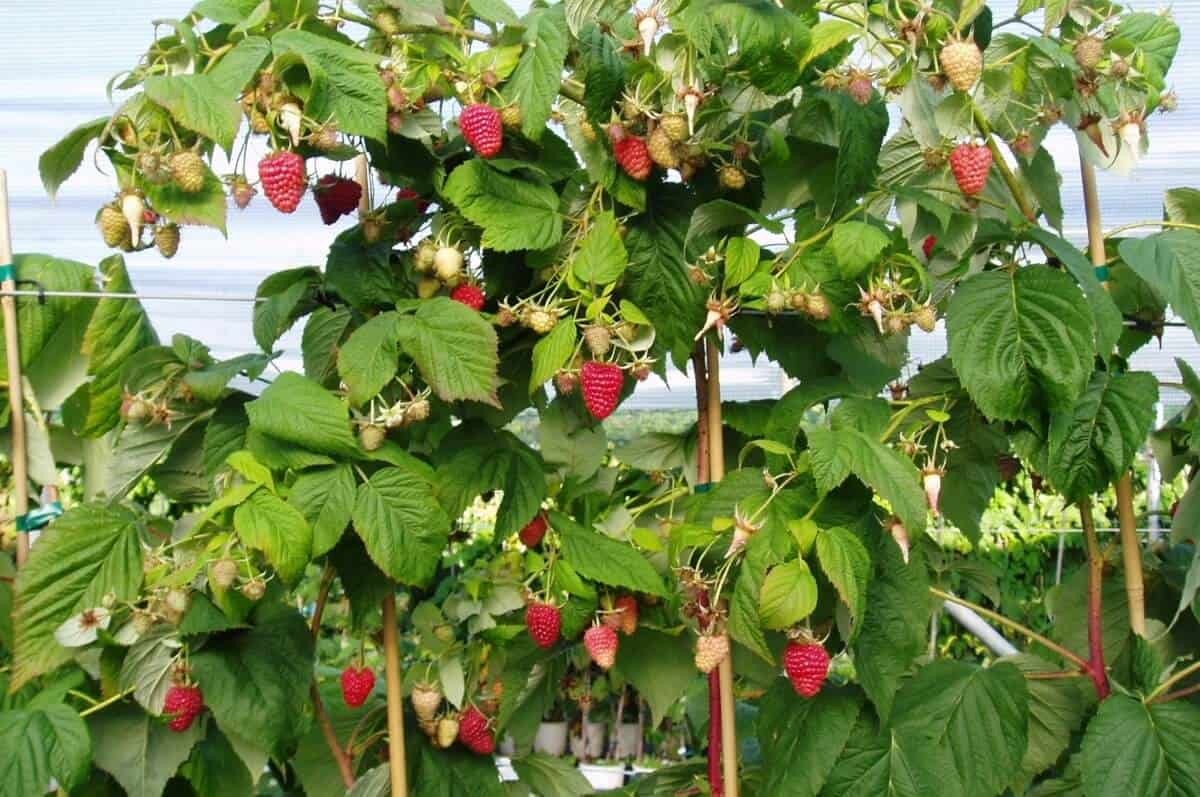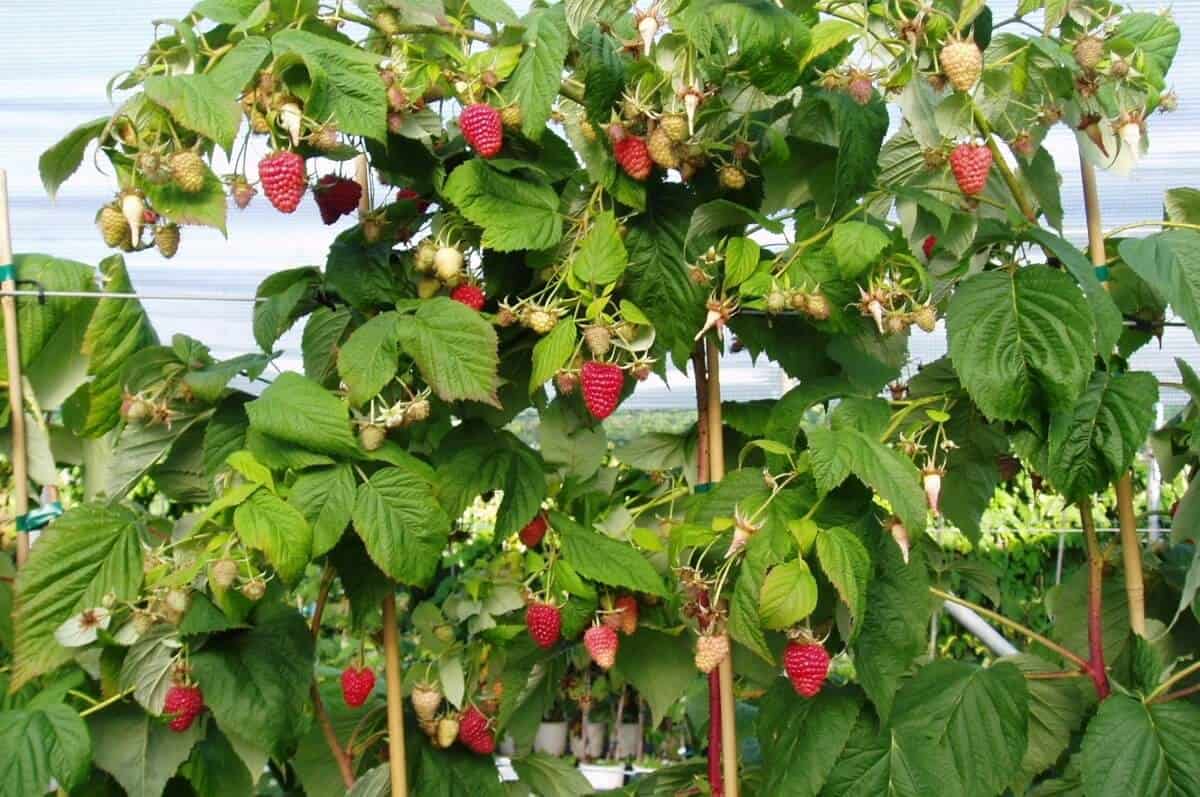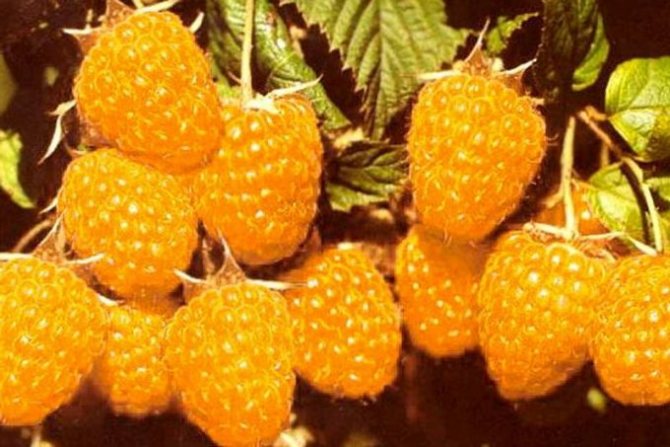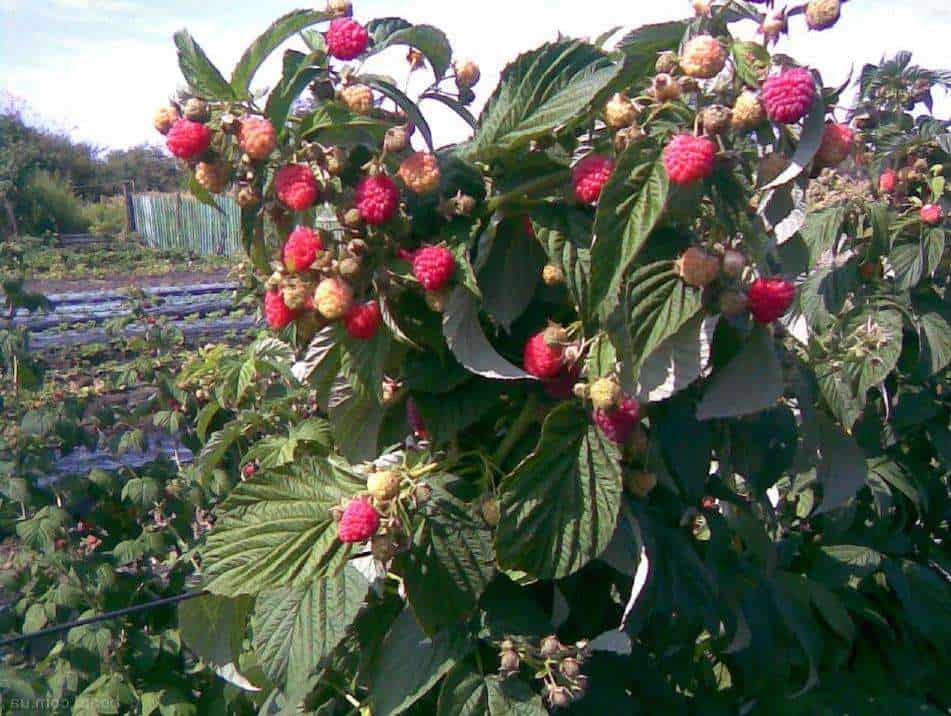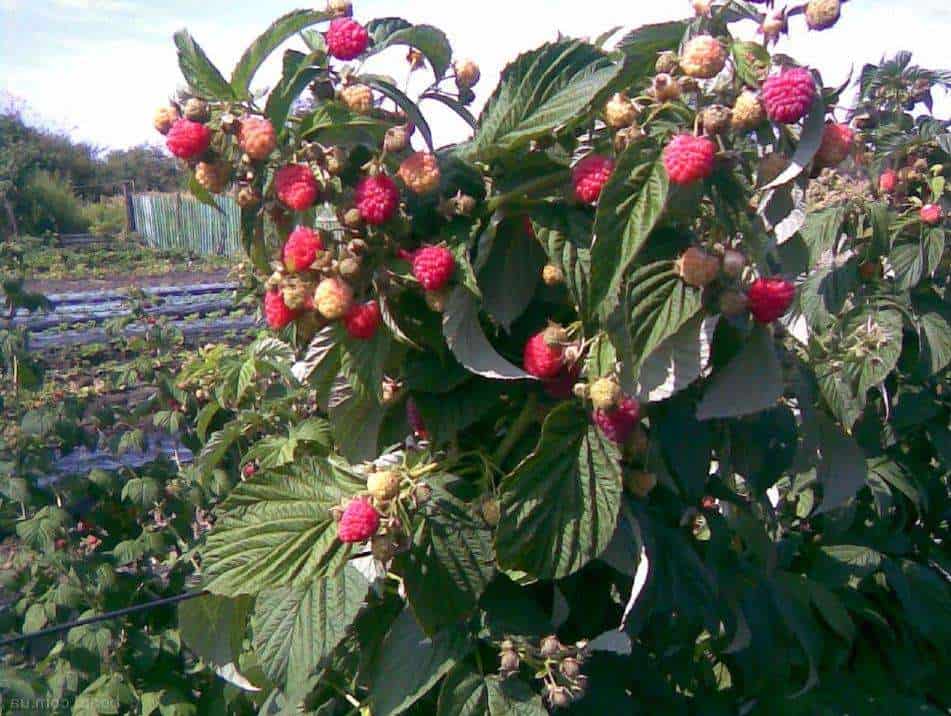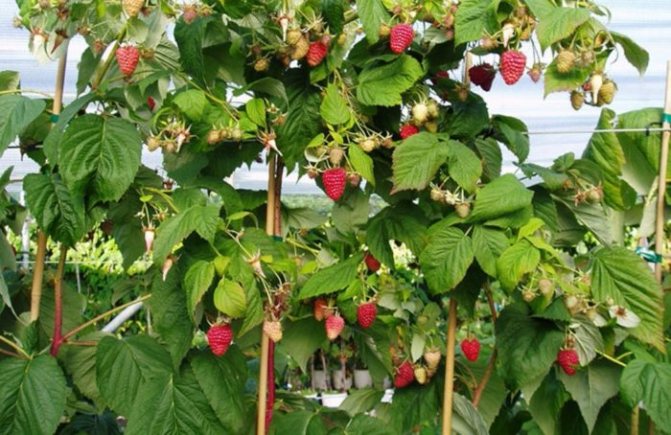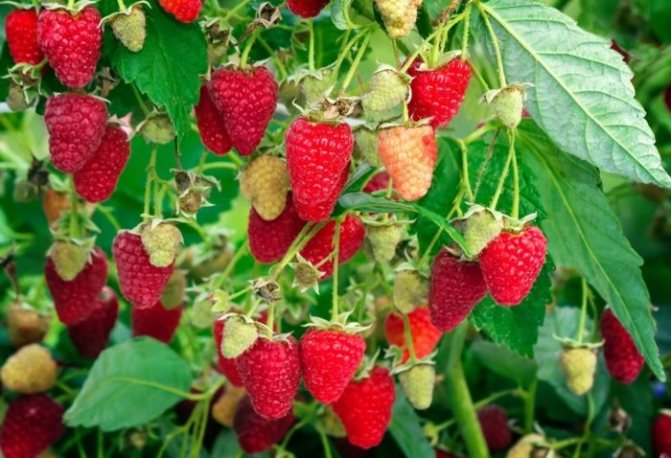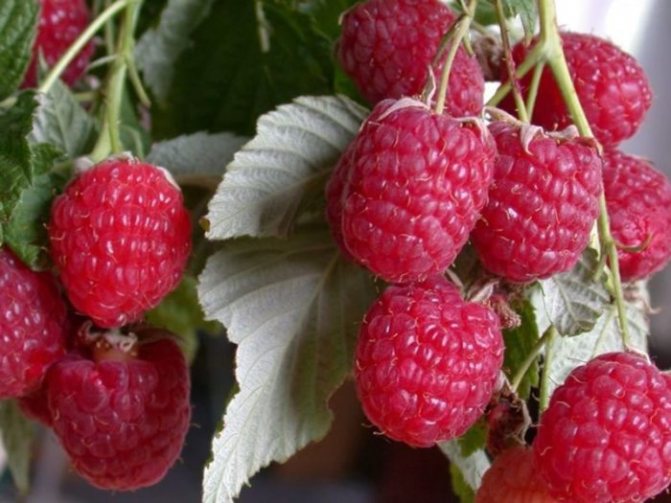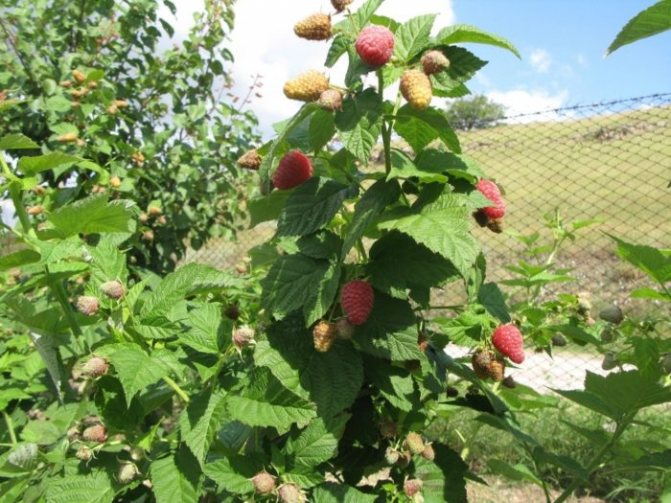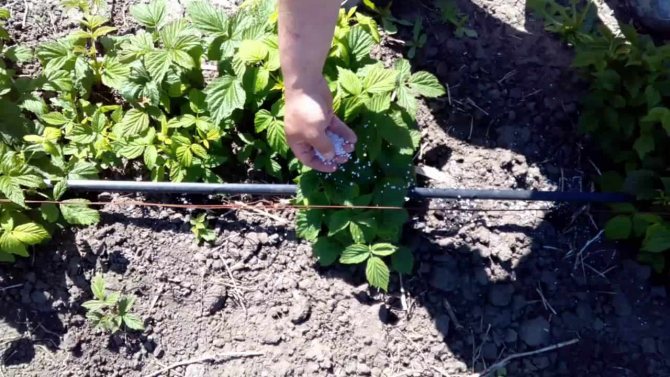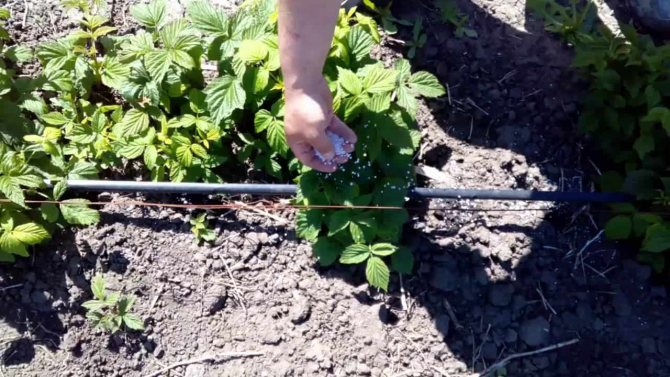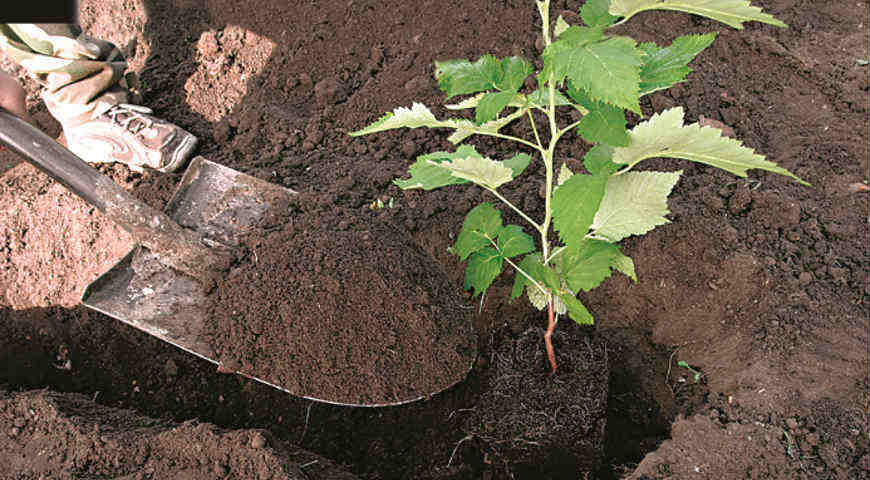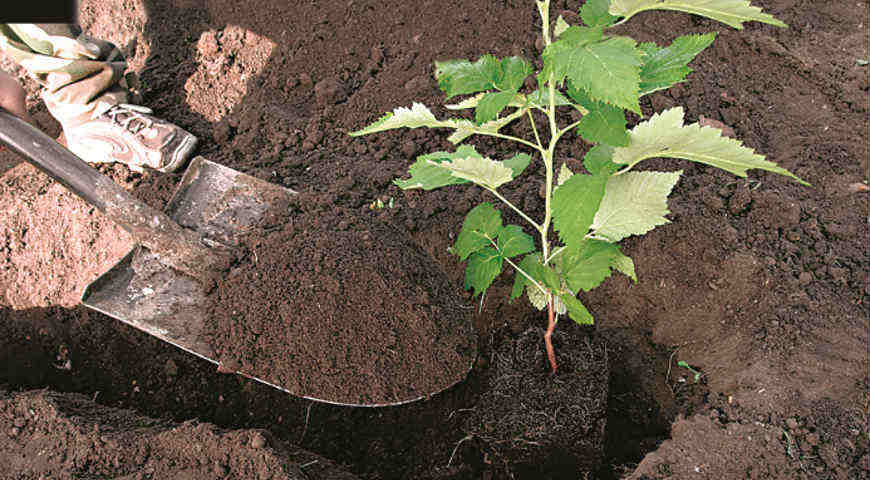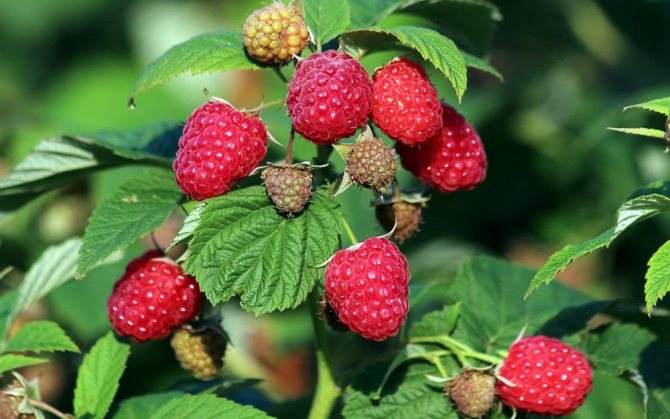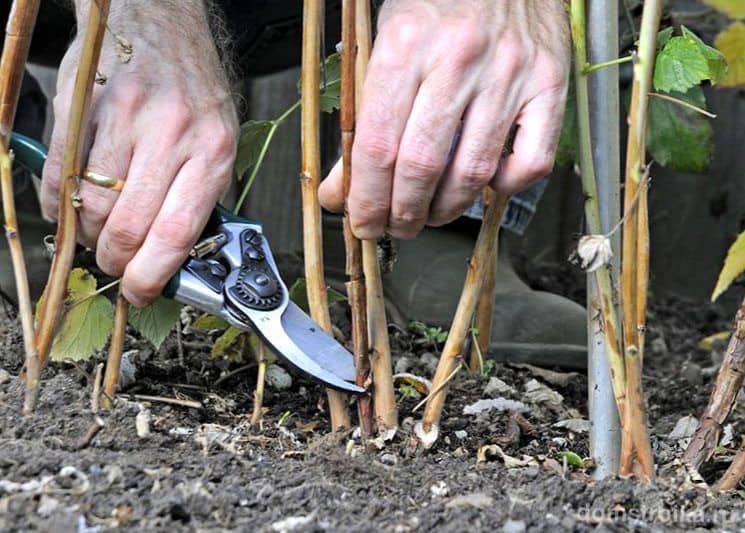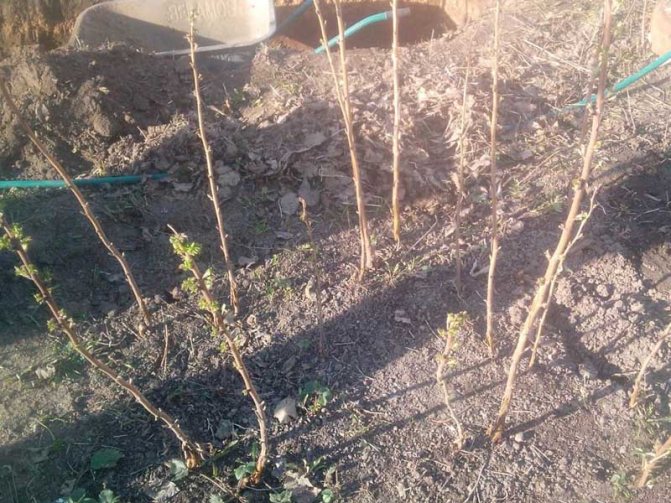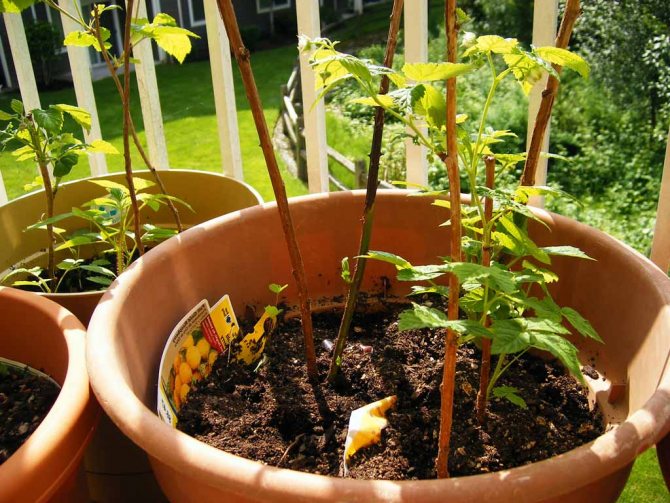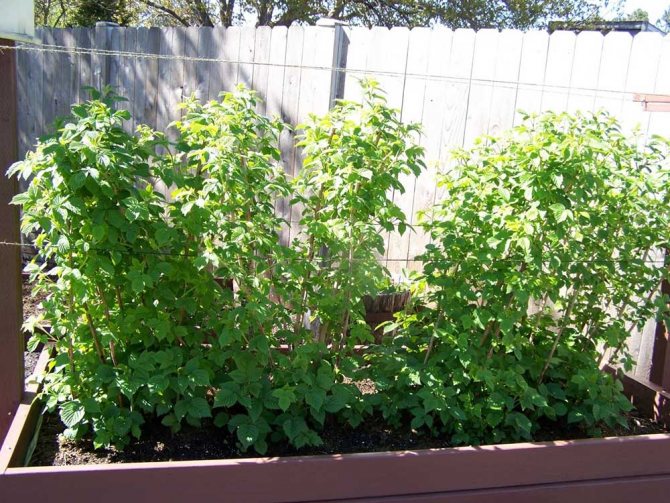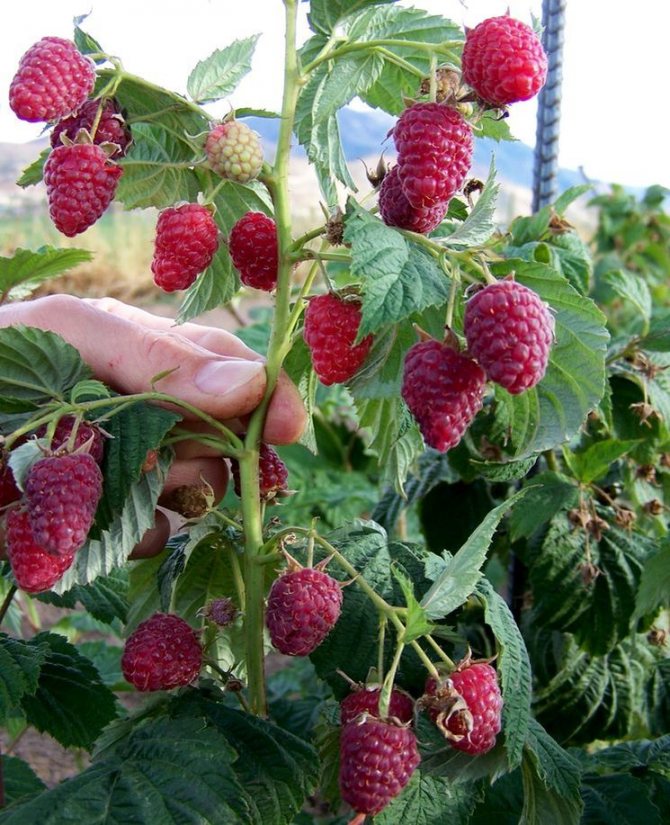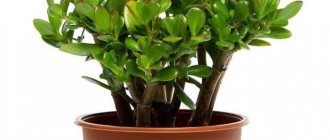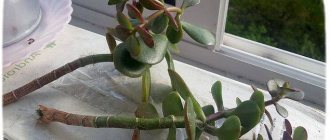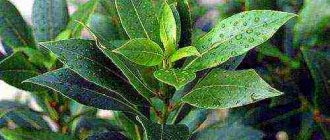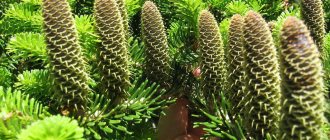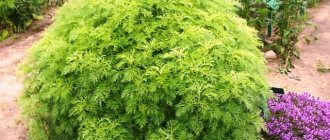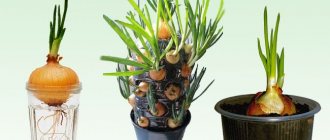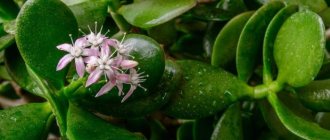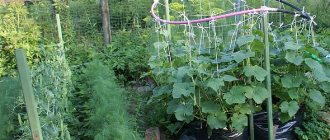Many gardeners, having heard the name raspberry tree, represent a tall shrub and a whole tree, from which large raspberries hang in huge clusters. But this is not the case. The bush has long, thick stems, but does not look like a tree, although its trunk is larger and does not droop under the weight of leaves and berries. Although shaping and pruning a bush, a certain visual similarity can be achieved.
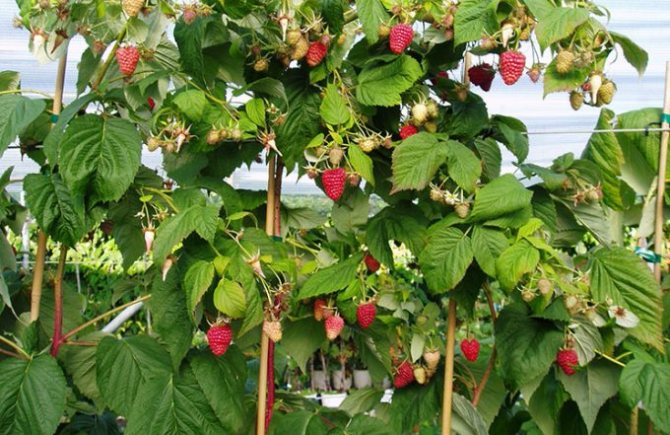
Description
Raspberry tree is popularly called common varieties of raspberries, but only standard ones. That is, they do not grow as a bush, but have one main trunk (stem) with branch shoots.
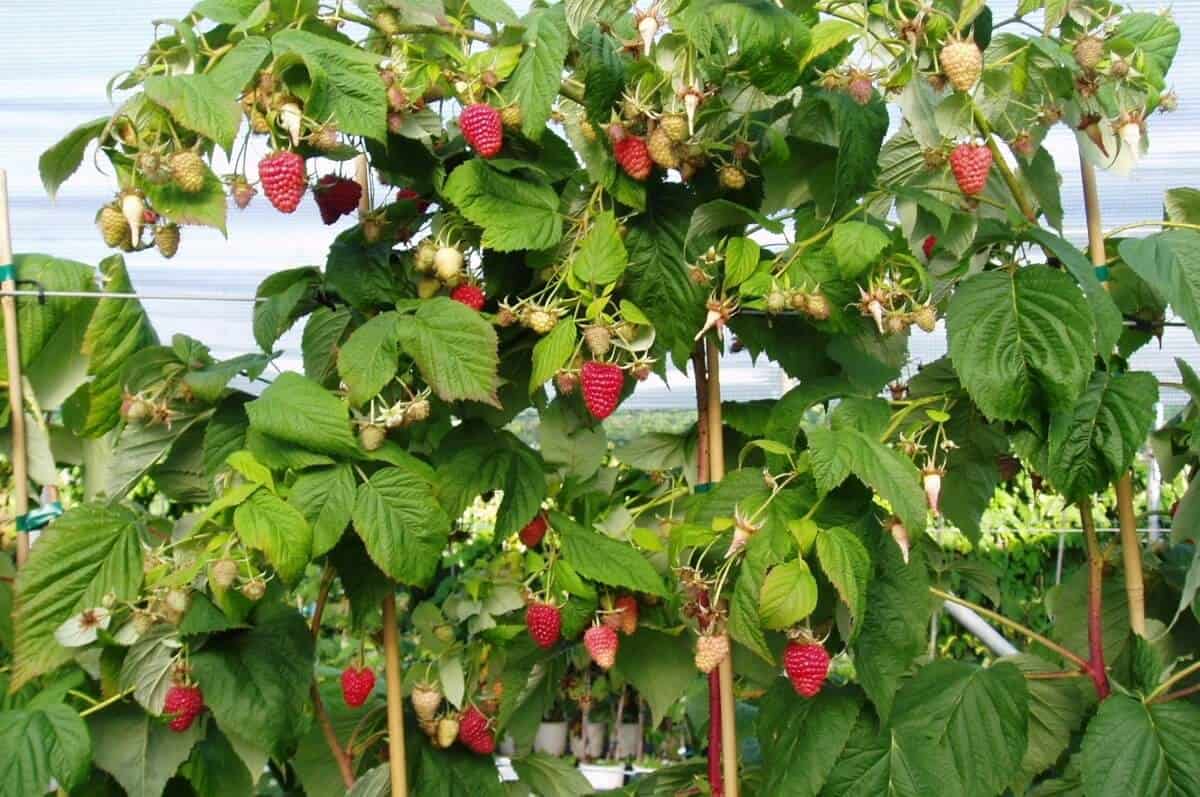

The trunk of a crimson tree is very strong and powerful, it does not bend under the gusts of winds, it is not characteristic of drooping. Competent pruning allows you to achieve the appearance of a small tree from the plant.
pros
- The raspberry tree is unpretentious.
- Thickening is not typical, which is beneficial to its health and productivity, avoids fungus.
- Root shoots are practically not formed, which greatly facilitates care.
- The yield is higher than that of conventional raspberry varieties, since the tree has many lateral shoots, and is taller.
- The fruits are large in size, quite tasty. They contain few seeds, which also has a positive effect on the taste.
- The harvest is good, stored well.
- Under the gusts of wind, powerful trunks and strong shoots do not bend, do not break. They also do not care about high yields: there will be no sagging branches, even if the berries are very large and heavy.
- The shoots of the plant do not need support and a garter, which greatly facilitates the work of the gardener.
- The raspberry tree is cold-resistant, which makes it possible to grow it in the northern regions.
- Long-term fruiting - berries can be harvested until late autumn.
Minuses
There are few disadvantages of this raspberry, but one is noted by almost all gardeners. The fact is that the fruits of the raspberry tree do not have such a rich taste and aroma as in ordinary, non-standard varieties.
Varieties
Today, the following varieties of raspberry tree are most popular with gardeners:
Note that raspberry Tarusa is the leader in this rating. It is very productive, it is possible to organize two-phase fruiting. In addition, Tarusa produces very large berries - fragrant and tender, easily separating from the bush. The plant is winter hardy and can be grown even in very cold regions.
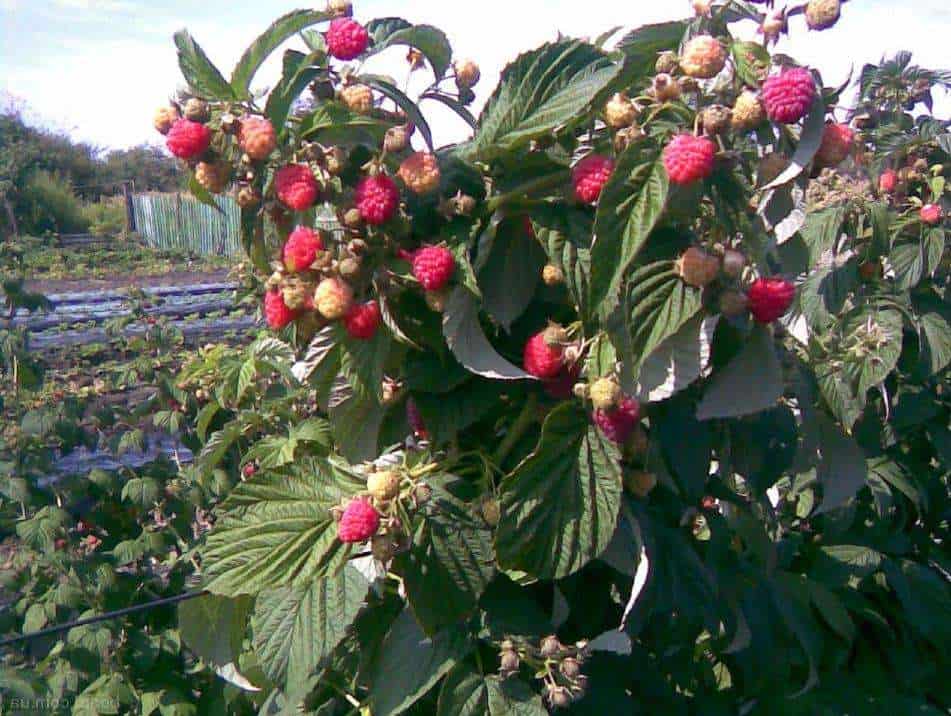

The Skazka variety is also interesting - in terms of taste, the berries of this variety are much superior to Tarusa. In addition, the yield is at a height: at least 10 kg of berries are harvested from the bush.
And if you want unusual raspberries, plant the Gold variety. The originality of the variety lies in the color of its berries - amber yellow. You should not wait until they turn red: the berries are ready to eat, being yellow. Let's note the taste and wonderful aroma of Raspberry Gold: during the fruiting period, the plant can serve as a real decoration of the site.
Advantages of the raspberry tree
If we compare the raspberry tree with common raspberry varieties, then there are a number of positive differences. Some varieties of raspberries can break under the snow, from the wind, if there are a lot of berries on them. The raspberry tree has a thicker stem that does not spread and can easily handle the heavy weight of the crop on the bush. Moreover, it does not need to be propped up or tied up.
There are many more berries on one bush, because it has many side shoots. This allows you to increase the yield of the plant. Its berries are heavy, but their flesh is firm and not watery. The fruit does not taste as sweet as raspberries, but they have few seeds.
The great advantage of the bush is its frost resistance. It can bear fruit until frost. He is not capricious and does not require special measures to take care of himself. Raspberry trees have practically no root growth, so the berry is easy to pick. They ripen quickly.
Landing
Let's get acquainted with the features of rooting a raspberry tree.
Seat selection
The plant should be planted in a sunny area: in the shade, it is unlikely that it will be possible to achieve good yields. The soil must be nutritious and loose: raspberries require a high permeability of the substrate.
It is important that the site is not low-lying: places where groundwater accumulates, a raspberry tree is categorically not suitable. In addition, care should be taken to protect the site from the north wind: although the tree is stable, drafts do not have a very beneficial effect on it.
To reduce the acidity of the soil, it is recommended to add lime before planting: an acidified substrate is not suitable for this plant. If the bed is located in a low area, you will have to form an embankment to protect the roots from rotting.
Neighbors
Take care that the following crops do not grow near raspberries:
Close proximity to the listed plant species can lead to infection with common infections and pests.
Site preparation
In order for the soil to meet the requirements for the level of fertility, it must be fertilized before planting the plant. It should be entered:
Fertilizers must be mixed with the soil and given time to absorb.
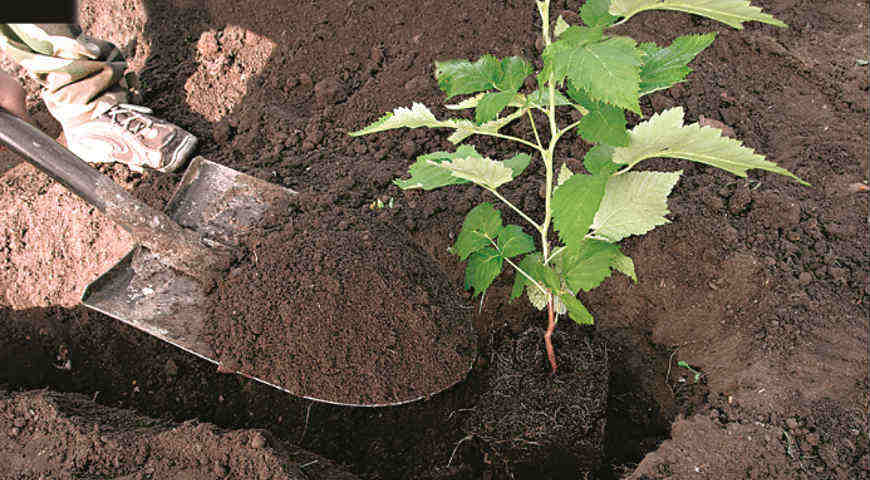

Timing
Planting a raspberry tree can be done in the fall: choose a period when the summer heat has subsided, but the first frost is still far away. But it is optimal to plant in spring: in this case, March or April is chosen.
Planting tips
- When planting multiple raspberry trees, try to place them further away from each other. This measure is associated with the need to rid the plants of thickening, shading. The minimum distance is half a meter, but ideally you need to maintain a long distance. The distance between the rows is 2, -2.5 meters.
- When planting several plants at the same time, it is more logical to dig not separate holes, but a common trench.
- The depth of the hole and trench should be 30 cm - the raspberry root system is superficial, does not go deep.
- Lay organic matter on the bottom of the grooves - humus, compost or peat. Sprinkle the layers with earth.
- It is very important when planting to avoid deepening the root collar of the seedling. It is permissible to dig it in only 2-3 cm, no more: otherwise, rotting is likely.
- After planting, the young plant is pruned. Leave only 30 cm of shoots.
Let's find out how to care for a raspberry tree for high yields of delicious berries.
Mulching
The procedure in this case is important, since there is a need to protect raspberry roots close to the surface from drying out.
Loosening and weeding is also difficult for this reason, so mulching remains the only way to ensure long-term root moisture, soil permeability and protection from weeds.
Top dressing
In order for raspberries to give impressive yields, you cannot do without additional nutrition. In the spring, it is recommended to add nitrogen-containing organic matter: manure or chicken droppings. Then you should switch to fertilizing with potassium and phosphorus.
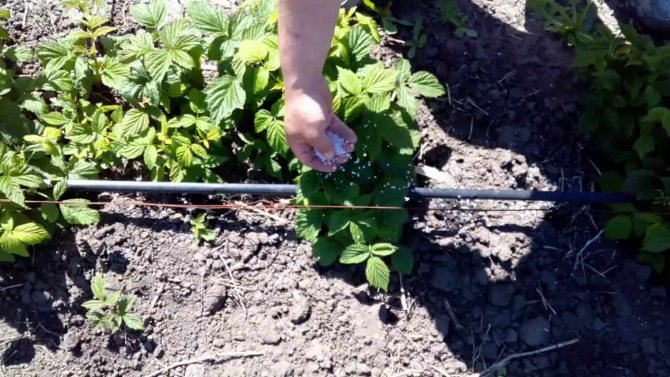

Prophylaxis
The raspberry tree has good resistance, however, sometimes, as a result of waterlogging or thickening, the fungus still affects the plant.
To avoid problems, it is necessary to take preventive measures.It is optimal to spray the plant with Bordeaux liquid: this drug is safe for the crop, and it poses a strong threat to the fungus.
Watering
Raspberries of standard varieties are quite sensitive to soil moisture. The plant experiences a special need for water in two periods:
- when the ovaries are formed;
- berries ripen.
At this time, you should water the raspberries once a week, at other times - once every 10-14 days.
But do not overdo it with watering, as waterlogging of the soil leads to rotting of the plant roots.
Pruning
To give the plant the shape of a tree, regular formative pruning is necessary. The procedure is carried out in two steps:
- In the first spring, the shoots are shortened by 5-10 cm to enable the plant to form a large number of fruitful branches.
- In the second year in spring, these same branches are shortened by 15 cm to form third-order shoots.
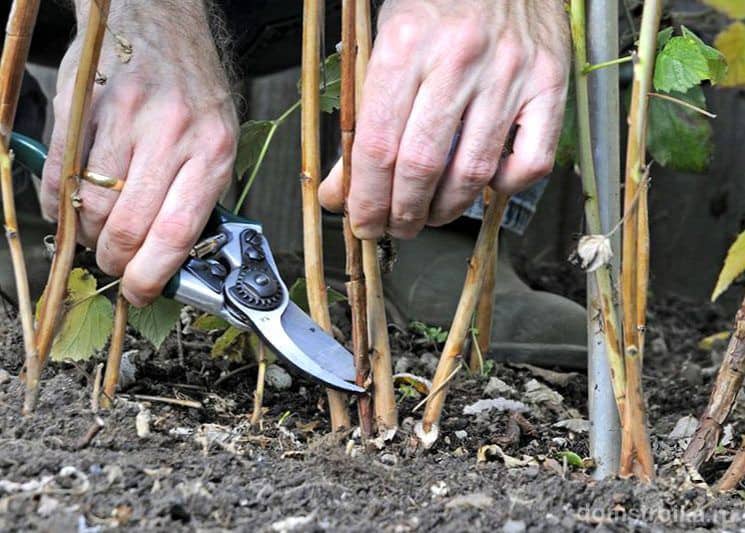

In addition, no one canceled the sanitary stage either: in the spring and autumn, remove old, dried, sick shoots. In the fall, you should also get rid of the shoots that bore fruit in the current season. The raspberry tree has a two-year development cycle, so only new branches will bear fruit in the next year.
Topping
A raspberry tree can bear fruit more than once a year, but two: but for this it is necessary to pinch the shoots correctly. The procedure is carried out in the fall, leaving sanitary pruning for the spring. Thus, the gardener has the ability to control the yield of the plant at his own discretion. Just remember that biphasic fruiting drains raspberries.
Wintering
A raspberry tree will survive frosts without shelter, but not strong ones. If the region is cold, it is necessary to take care of protection. To do this, the raspberries are bent to the ground, covered with agrofibre on top.
Transfer
Ten years after rooting, the raspberry tree must be transplanted to another place. This measure is connected with the fact that in the old place the soil is already pretty depleted, and the yield decreases because of this. It is recommended to plant green manure in the old plot for soil restoration.
How to choose a seedling for planting
You should not turn to street vendors in this matter. If the gardener does not know what the seedlings look like, then he can get the usual shoots dug up on an abandoned field or plot. If by an adult plant you can understand a raspberry tree or a raspberry, then by a young one it is almost impossible.
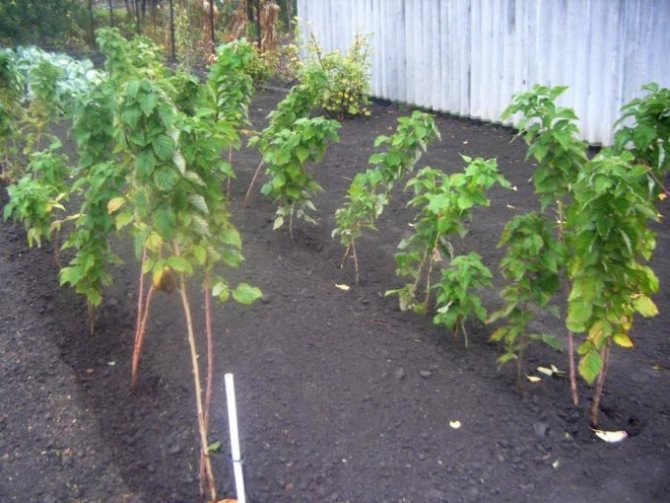

Therefore, it is better to buy seedlings of standard varieties in stores for buying seeds or in nurseries. If there is no specialized store in the village, then you will have to go to the market. In this case, it is better to ask the seller for a certificate for the products sold to make sure that the purchased seedling is a raspberry tree.
You should also carefully examine the bushes for mechanical damage, frost-bitten areas, various spots and other defects. A healthy raspberry tree should have slightly damp roots. Several buds and stems have already formed on it. Such planting material takes root and grows easily.
The packing of the roots is an important factor. It cannot be wrapped in polyethylene. The roots of seedlings in nurseries are wrapped only in paper or natural fabric.
Bush formation
To form a bush like a small tree, you need to prune the branches in two steps. First, young shoots need to be pinched in the first month of summer. During the time from planting, the plants should stretch to a size of at least 120 centimeters. They are cut to ten centimeters. The branches stop growing and lateral shoots begin to grow. From summer to autumn, there are about a dozen of them. The length of such stems is from 40 to 90 centimeters.
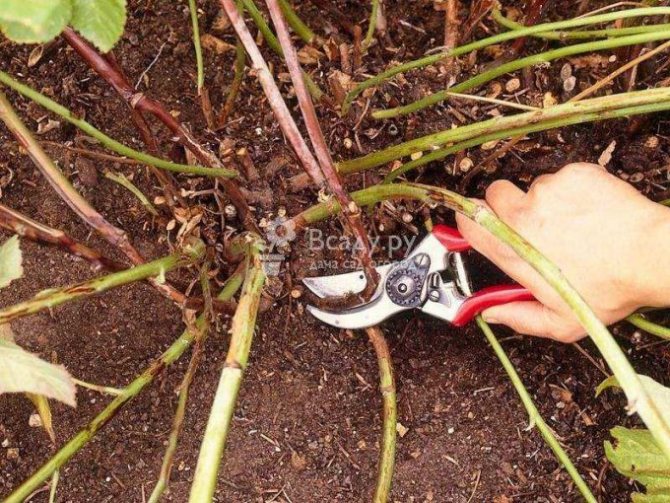

The following spring, the old branches are cut and the lateral shoots are cut to a size of about 40 centimeters. Up to ten berries will appear on lateral branches closer to the middle of summer.This method of care forms the bush and improves the yield of the plant. Moreover, if the first pinching is carried out late, then the lateral shoots may not ripen and will simply die with the onset of frost.
Popular: Restoration and stimulation of orchid flowering with succinic acid
How the raspberry tree reproduces
Reproduction of these varieties of standard raspberries is possible by dividing the bushes or using root cuttings.
Propagation by cuttings
To propagate an adult bush, the gardener must dig it up and carefully cut off layers of about 10 centimeters in size. They must have at least three buds. You do not need to cut more than four cuttings at once, so that the mother's raspberry tree does not weaken and stop growing.
After that, the selected cuttings must be buried into the soil at a distance of about five centimeters. Layers are watered and covered with polyethylene. After the first shoots appear on the cuttings, the film can be removed.
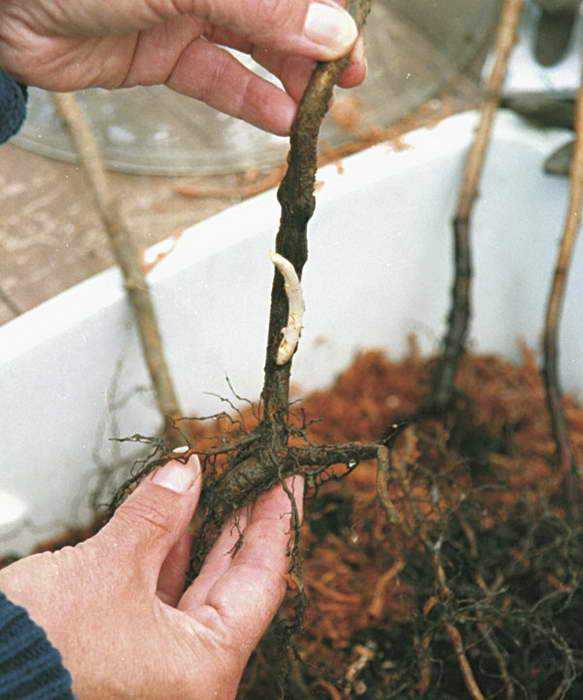

Another way of rooting cuttings is possible. To do this, tie the resulting layers in 2-3 pieces and put them in a container. A mixture of sand and peat is poured into the container. These ingredients are taken in equal proportions. In this form, the cuttings are removed to winter in a basement or other dark, cool place. In April, they are planted like regular raspberry tree saplings.
Reproduction by dividing the bush
If the plants have little overgrowth near the roots, then it is better to propagate such a bush by dividing. This procedure is performed during the spring or fall months.
An adult bush should be dug up and, together with an earthen lump, pulled out of the hole. It is divided into several parts so that in each lobe there are three strong branches with a developed root system. Each part of the bush is planted in a separate hole.
Application of culture
The berries of this plant are used in cosmetology, and tasty and healthy jam is made from the fruits. Even after cooking, such fruits do not lose their beneficial properties.


These berries are easy to transport, unlike raspberries, they practically do not wrinkle. They can be frozen and even dried. They and the branches of the raspberry tree are used to treat colds during epidemics, and they also treat diseases of the gastrointestinal tract. Tea with brewed branches of the plant is quite useful.
Reproduction
The raspberry tree is propagated in two main ways:
Note that the first option is rarely used, since the standard varieties form little root growth. However, if you manage to get hold of the cortex, it will take root quickly and take root without any problems.
The procedure is simple: the scion is dug out of the ground along with part of the maternal root. Immediately he lands in his separate place, where he soon takes root safely.
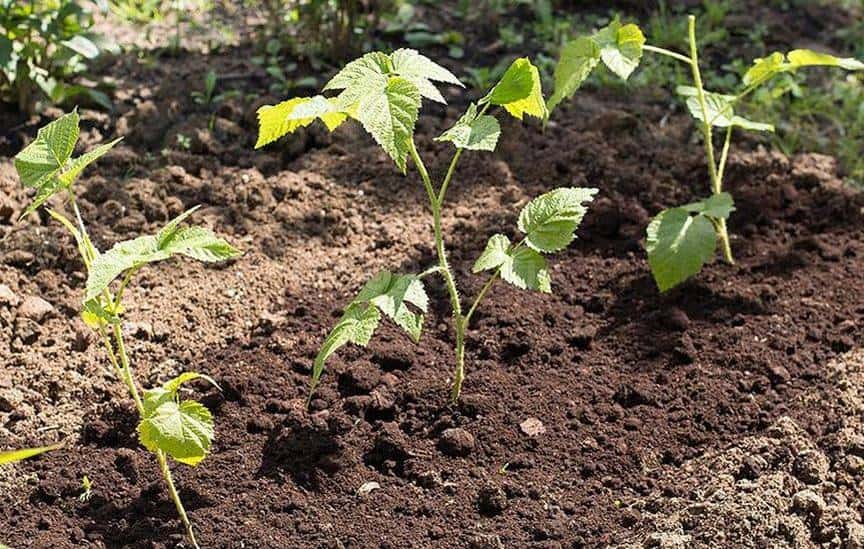

Important: in order to stimulate the formation of root shoots, it is recommended to cut the shoots to the base.
Cuttings
This method is used more often, although it is more complex. In order to obtain high-quality cuttings, the mother bush is undermined, separating parts of the roots from the buds. After separation, these parts are grown in a peat substrate, then rooted. Cuttings will be ready for planting in open ground in a year.
Raspberries in the fall - planting raspberries before winter
Most likely, seedlings of almost all types will take root, but for the full success of the business, it is advisable to take into account such agrotechnical points:
- Prefer winter-hardy varieties, since those that are more sensitive to frost can suffer significantly or die completely - they, of course, are propagated in the spring;
- Favorable weather conditions are more important for the central and northern regions, and in the south of Russia and in areas with a temperate climate, where autumn planting of raspberries is used most of all before winter, there are almost no problems with the weather;
- We are in a hurry to taste raspberries in the coming season, since the spring planting can only promise it next summer, that is, in a year.
What is a raspberry tree and how to grow it in your country house
Hello my dear friends! Today you will not surprise anyone with standard raspberry bushes, which grow throughout the entire territory of the site in a couple of years, so I want to tell you about a relatively new technology for growing this berry. Let's talk more specifically about what a raspberry tree is, planting and caring for a video of the process of growing this plant.
I will also introduce you to the peculiarities of standard raspberries and Tarusa raspberries, I will try to briefly describe the method of growing them and the potential difficulties that you may have to face when working with these varieties.
Repairing varieties of tree raspberries
The most popular among the remontant varieties of standard raspberries:
Penguin
Differs in good transportability, resistance to diseases and pests. Fruits are large, of average taste. High yield, but only with regular feeding. Average frost resistance, shelter is required for the winter.
Eurasia
Large-fruited variety with a friendly yield. Not pretentious to the composition of the soil and growing conditions. Resistant to major raspberry diseases and parasite attacks.
Forms few shoots, simplifying care for gardeners, there is no need to waste time cutting unnecessary shoots.
The fruiting raspberry tree Eurasia looks very original and is used to decorate a garden plot.
Galaxy
The bushes are very compact with strong branches. The berries are delicious, extraordinarily sweet and tender. The tree is unassuming to care for, gives a small amount of growth. Shows excellent resistance to diseases and gives stable annual yields.
Bogatyr
Powerful stems do not bend in the wind. Juicy berries with a memorable honey aroma. Ripens in June, the yield is about 5 kilograms per bush.
Large berries do not crumble after ripening for about a week and at the same time are very juicy with a pleasant taste and aroma reminiscent of forest raspberries.
The hero forms many replacement shoots (about 10) and more than 7 offspring, it is very good for reproduction, but it is a little difficult to care for.
When and how to plant standard raspberries
The best seasons to plant are spring and fall. Given that each reader may have their own climatic conditions, I strongly advise you to check the planting calendar before planting. The most optimal months are April and September.
The soil should not be acidic, ideally you need to find a quiet, windless place. If in winter the snow layer does not warm raspberries from the cold, then you will have to take care of protection from frost on your own. Reproduction of raspberries occurs due to the growth. A sprout for planting on another part of the garden can be used when it reaches 25 centimeters.
- bush (for each seedling, separate holes are dug and fertilizers are added, the distance between the holes is about a meter);
- tape (plants are planted in a dug trench, at a distance of half a meter from each other, it is also recommended to use fertilizers);
When to plant raspberry seedlings in autumn?
It is not easy to determine the exact timing of planting raspberries before winter, but the main principle is that before the onset of stable freezing cold there should be no more than three weeks. The dates of the lunar calendar for those who like to follow it suggest the following dates in September 2019:
- favorable days for planting raspberry seedlings in the fall - 1-4, 7-9, 17-19;
- unfavorable days for planting raspberry seedlings in the fall - 10, 11, 14, 20-22, 25, 28.
Planting dates for raspberries before winter in different regions
In central Russia and the Volga region, raspberries are planted before winter in September-October. In Siberia, the Urals and in the northern regions, these dates occur within the end of August - beginning of September. In the southern regions, the period of autumn planting of raspberries can be extended from September-October to the second half of November.
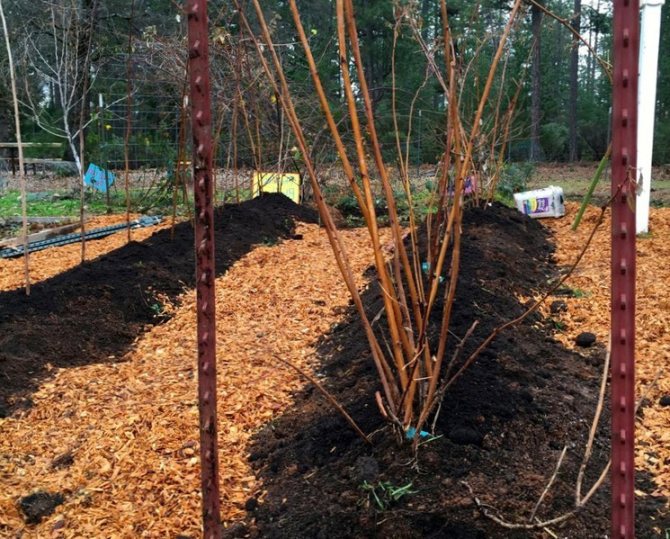

For your information! If already in August cool and rainy weather is established in your climatic zone, then planting raspberries in such conditions can lead to the disease of the planting material with fungal infections and its complete loss. In this case, it makes sense to book a young raspberry tree in the spring.
About raspberries Tarusa
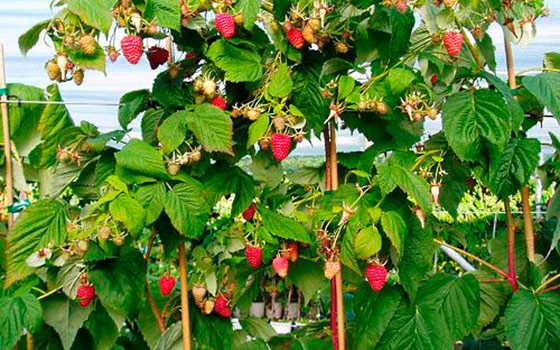

Speaking of raspberry varieties, one cannot ignore the Tarusa raspberry tree, which was the result of crossing the Capital variety and the standard tree. It was brought out by V.V. Kichin. in 1987.
The peculiarity of the Tarusa raspberry is that for its cultivation there is no urgent need to use trellises and stakes, moreover, it is one of the most productive varieties, which, moreover, does not have thorns.
Shoots of this variety can grow up to 2 meters in height. Despite the fact that raspberries hold tightly to the stalks, it is very convenient to harvest the fruits. You can get 4 kilograms of raspberries from one plant.
Site selection and soil preparation for planting raspberries Tarusa
If you decide to grow a raspberry tree for a long time and seriously and have opted for the Tarusa variety, then the best place for its growth will be a flat, protected from the winds, well-lit by the sun section of the garden.
Snow should accumulate here in abundance. There should be no old raspberries in the selected area. You cannot plant and grow this berry between other trees, where it will not receive enough light and nutrients.
If the area is flooded, dig shallow channels to drain it. The level of the site still needs to be raised using bulk soil for this. For good plant growth and a high yield in the future, sow the area set aside for planting raspberries with legumes, rapeseed or mustard.
Choose a loose soil for raspberry, rich in valuable nutrients, moderately moist. Lime highly oxidized soil a year before planting at the rate of 300-500 grams of lime per one square meter of land.
When and how to plant Tarusa raspberries
Planting time depends on the region, but the most optimal period, most often it is autumn (mid September - late November) and spring (early March - late April).
The landing algorithm looks like this:
- Dig holes at a distance of half a meter from each other.
- Add fertilizer.
- Place the seedling.
- Dig a hole in the ground and tamp.
- Cut off the shoots, leaving a maximum of 25-30 centimeters.
- Mulch the soil.
- Water the seedlings (one bush requires approximately 5 liters).
- Isolate raspberries from direct sun for the first couple of days.
Planting tree raspberries
For rapid development and active fruiting, it is necessary to take a responsible attitude to the choice of the location of the future raspberry tree. The best option would be well-lit by the sun, calm places, for example, a meter before the fence.
It is contraindicated to plant solanaceous and garden strawberries in the neighborhood, these types of plants have common pests and diseases, and constant neighborhood contributes to their reproduction and rapid accumulation.
The soil for the raspberry tree needs a fairly light and loose, with good air permeability. The acidity is preferably neutral or slightly acidic; with increasing pH, dolomite and lime flour is added.
Raspberries can actively develop and bear fruit in one place for 8-10 years. Subsequently, the process of accumulation of diseases and parasites begins, and the bushes simply degenerate. A transplant is required to a new location.
Site preparation
Raspberry is a rather unpretentious plant, it can develop successfully and bear fruit without human help. But it takes a little work to get bountiful harvests.
Soil preparation rules:
- Destroy all weeds, they serve as a source and accumulator of diseases and pests. Close attention should be paid to creeping wheatgrass.
- Dig up the area under the raspberry tree to the depth of the shovel bayonet.
- Evenly apply rotted manure and mineral fertilizers during digging.
- Prepare the landing pits.
Among weeds, wheatgrass creeping causes particular harm to plantings, it multiplies incredibly quickly and uses a lot of nutrients and water.
There are two ways to deal with it: manually dig up all the rhizomes in the area or treat it with a fungicide, for example, with Roundup. It is better to immediately get rid of this weed than to constantly fight with it in the raspberry tree.
Planting scheme for raspberry trees
Treelike raspberries are planted by the bush and tape method.
Bush planting option
Distance between trees 1.5 meters, between rows about 3 meters. Thickening leads to a decrease in the number of fruits, as well as a deterioration in their quality.
The landing pits are made 1-1.5 meters long and 30 centimeters deep. The bottom is lined with peat, then humus and sawdust, mineral fertilizers are added, everything is covered with fertile soil on top to avoid direct contact of the roots with fertilizers.
Tarusa seedlings care
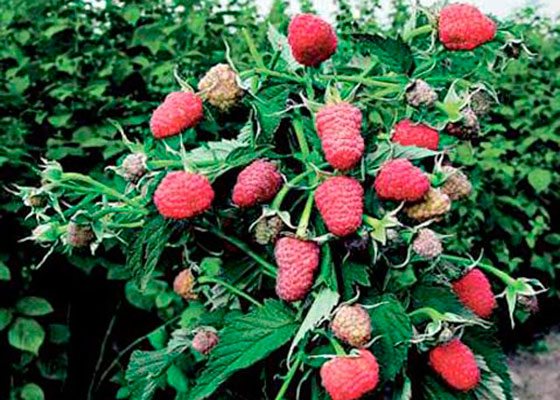

Taking care of the Tarusa raspberry tree is completely uncomplicated and consists in the following:
- watering;
- soil mulching (in case of heat);
- fertilizing with fertilizers;
- weeding;
- spraying special solution (in case of frost or mechanical damage);
- the formation of bushes;
- insulation from the cold (important in the first year);
- disease and pest control.
Enemies of Raspberry Tarusa:
- raspberry moth;
- raspberry-strawberry weevil;
- raspberry beetle;
- chlorosis.
Caring for planted raspberries before winter
Raspberry seedlings are watered according to the above rate on the watering circle, followed by protective mulching with peat, rotten sawdust, hay, excluding fallen leaves, which can become a source of fungal infection and pests. It will be useful to prevent the soil from fungal infection with copper sulfate.
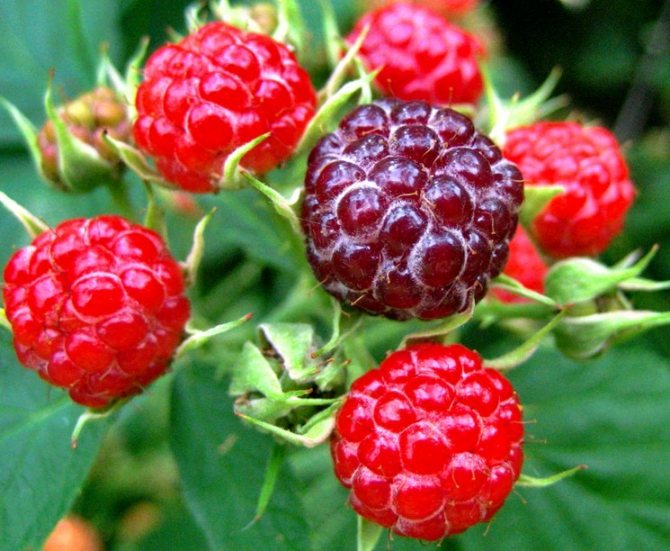

Further watering should be carried out as needed, subject to warm and dry weather, without waterlogging, dangerous by decay of the root system of plants. Lack of moisture can lead to freezing of raspberry bushes, to diseases and instability to pests. As a result, to the loss of the expected high-quality raspberry harvest.
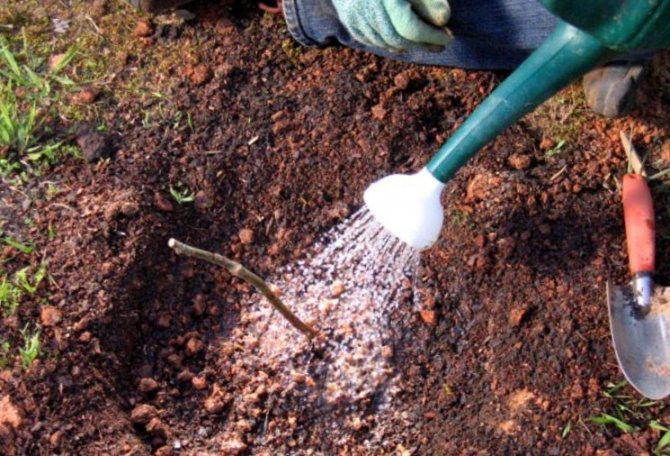

Raspberry bushes of autumn planting, having safely survived the winter, with the subsequent correct regular renewal of the raspberry tree, leaving in spring and summer, will delight gardeners with fruiting in July and August. For spring planting - only next season.
For your information! The varieties of remontant raspberries: Gusar, Polana, Polka and others are prepared for planting and planted according to the general rules. But the depth and diameter of the landing hole are made several centimeters larger.
An important stage in the preparation of raspberries planted for winter, especially in cold regions, is its dense mulching, in which the mulch layer should be at least 15 centimeters thick. In addition, when forecasting a severe winter, it is advisable to use covering methods: overlay with spruce paws, cover with covering material, if there is a snow cover, throw snow on the planting of raspberry bushes.
Harvesting
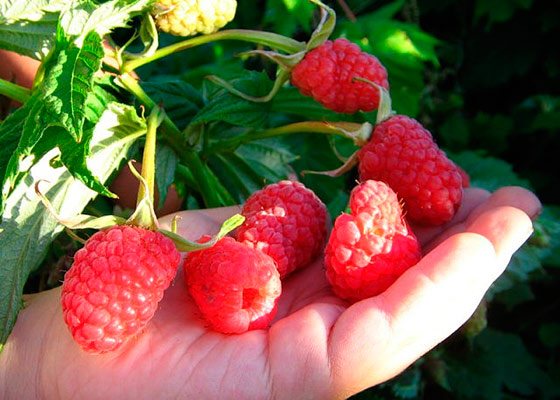

Do not pick raspberries immediately after rain or dew to avoid quick spoilage. Raspberries with stalks have a longer shelf life and are easier to transport. Harvest every two days as ripe berries appear (usually mid-July), avoid sprinkling, as the fruits wrinkle from this.
As you can see, a raspberry tree can give not only a rich harvest of delicious berries (with proper care), but also decorate your plots with its not quite ordinary look. Do not forget to repost this interesting article for your friends, as well as subscribe to new publications on my blog.
Useful properties of raspberries
The raspberry tree, the photo of which is presented in the article, gives tasty, fragrant and very healthy fruits.They have a wide range of medicinal properties and are widely used in traditional medicine. The berry is rich in organic acids, minerals and tannins, essential oils, glucose and fructose.
Traditionally, the fruits, leaves and flowers of the raspberry tree are used for colds, flu, to treat pain in the joints and back. Raspberry helps to cope with fever and neurological diseases, has antipyretic, hemostatic and antitoxic properties. It has a tonic effect on the skin of the face, normalizes blood pressure.
Raspberry leaves contain substances that stimulate the intestinal walls. These berries are always present in the diet of pregnant women, since the folic acid they contain is essential for the formation of the fetus. Raspberries, unlike other berries, do not lose their beneficial properties during and after heat treatment.
Raspberry tree Tarusa - the most productive variety
The fastest growing and most fruitful of berry crops is raspberry. Its fruits are very tasty and healthy, they love it fresh, they make preparations for the winter from raspberries, they can be dried. Therefore, raspberries are grown on every home or summer cottage, a raspberry tree receives a lot of positive reviews.
Currently, there are many varieties of this shrub, which allows you to get fresh products for a long time, picking up several varieties with different fruiting periods.
Soil preparation for planting
For planting bushes, it is necessary to prepare a garden bed with fertile soil. Before planting, the substrate is enriched with humus, fertilizing with manure is possible.
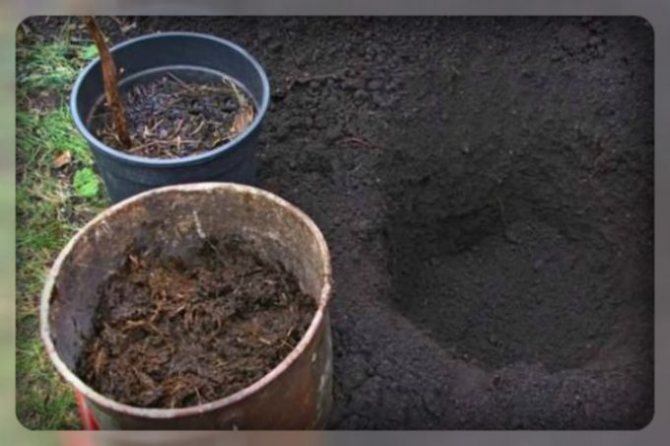

If there is no organic fertilizer, it is recommended to enrich the soil with mineral fertilizers. If you do not fertilize the soil, then the crop yield will be low, the berries simply will not ripen.
When growing on one site of bushes of a raspberry tree for 10 years, the soil is depleted. Therefore, it is recommended to transplant the plants to another part of the garden plot. In the old area where the culture grew, it is better to plant cereals. For five years, the soil at this place is restored.
Raspberry tree - what is it?
The raspberry tree includes the standard varieties of this berry, varieties that do not need support when growing. They hold well, the branches of the bush can bend under the weight of the berries, but they will not fall, as they are tough with shortened internodes. The raspberry tree is not a variety name, but a cultivation method.
With this method of growing a shrub, the branches that have bearing fruit are cut out and the tops of young shoots are pinched, which leads to the awakening of the lateral shoots. Leaving only one replacement shoot, you can get an erect, tree-like, non-leaning bush.
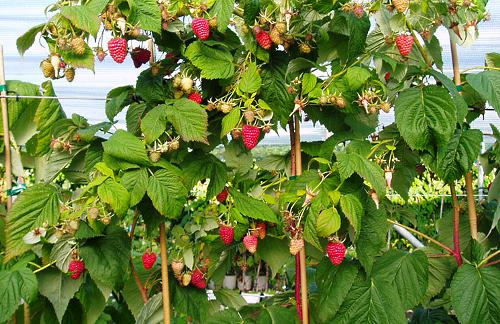

The number of side shoots of growth in standard raspberry varieties reaches 10 pcs. By autumn, they have a length of about 50 cm. After the leaves fall off, the bush looks like a small tree, which gave reason to call it that. With optimal care, such a bush will yield a yield that is much larger than a plant that has not been formed in this way. Increasingly, summer residents grow a raspberry tree on their site, reviews of which are usually positive.
Shaping and pruning the Tarusa tree
The raspberry tree Tarusa is formed by the method of double pruning. The first time the shoots are pinched in May in the year of planting, when their height reaches 60 cm. The stems need to be shortened by 5-10 cm. Thanks to this procedure, the buds will begin to awaken in the axils of the upper leaves. And in the fall, lateral branches will grow on the shoot.
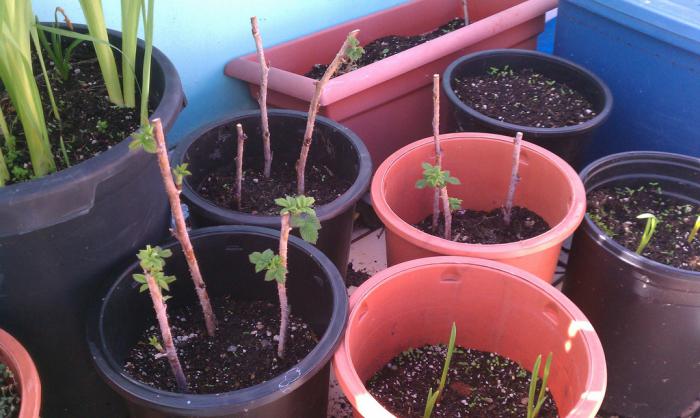

The second pinching is carried out next spring, but the lateral growths are already pinched. At the onset of frost, cut off the branches immediately, otherwise the shoots will not ripen by autumn. Thus, pinching the branches at your own discretion, you yourself form a tree of the desired shape. After the second pinching, many fruiting branches appear on the stem, from which a rich harvest can be harvested in the fall.
Why choose the Tarusa raspberry tree
One of the most promising modern varieties for personal farming is the Tarusa raspberry tree, it has:
- High productivity, with appropriate pruning, it can give two crops per season. The berries are very large (up to 14-16 g), beautiful elongated shape with a bright red color and shiny. They are easily removable.
- Berries with excellent taste and aroma, firm and withstand transportation well. The berries of the Tarusa raspberry tree can be consumed not only fresh, but also for all types of processing, because they have few seeds and they are very small.
- The root system resembles the root of a tree and does not give a lot of growth, that is, it does not "spread" over the site. When raspberries are grown for berries, and not for planting material, this quality is a big plus.
- It is possible to grow without supports or stakes, since the plant has tough, thick and strong shoots that do not have thorns.
- High winter hardiness and relatively good resistance to many diseases.
Other features of the variety
This raspberry is a mid-late variety. The bushes, with proper care of the raspberry tree, are powerful, compressed, of medium height and pronounced erect, up to 1.5 - 2 meters high. The leaves are very beautiful and large, with a corrugated surface and a dark green color. The plant is very beautiful in general and can be used for decorative purposes as well.
How to plant a raspberry bush
To plant a raspberry tree, you need to find a place full of sun, in which there is no wind. The wind can injure bush branches, and in winter it will blow out the protective layer of snow. Additionally, the bush can be insulated in winter by throwing snow.
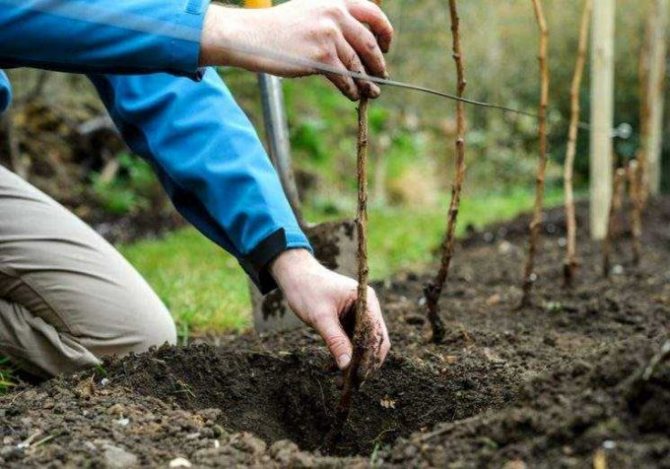

Seedlings should not be grown in soil where previously there were potatoes or pumpkin seeds. And also you should not plant it in the ground, where before that there were beds with pepper.
Prepare a garden bed under a raspberry tree along with a fertile substrate. And the groundwater level (how to determine) in this area should be deep. Here the raspberry tree will grow actively and will soon begin to bear fruit. The roots of the plant should not be waterlogged so that they do not rot.
Before planting, it is necessary to soak the roots of the shrub in a mixture of clay and manure. This will help speed up rooting. When planting, the gardener should form a hole about 50 by 50 centimeters in size. The gap between the holes should be left about one meter. The main stages of caring for a raspberry tree during the growing season are considered to be the correct regime of watering, fertilizing, weeding and loosening. It is necessary to spray the standard varieties from pests.
Growing and caring for the Tarusa raspberry tree
Since remontant varieties of raspberries continue their active vegetative development in the fall, the planting of a raspberry tree is carried out only in the spring. The plant planted in autumn does not have time to mature and dies from frost. In the year of planting, one should not expect a large harvest, the young bush will lag behind in development from those previously planted.
The raspberry tree grows thick and wide, so it is necessary to plant at a distance of a meter from bush to bush, and at least 1.8 m is left between the rows.In order for the raspberry tree to develop well, planting is accompanied by top dressing, that is, humus or peat with manure. Repaired raspberry varieties need fertile soil.
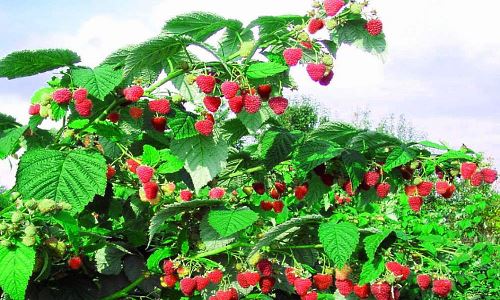

During the growing season, the plantings are necessarily watered abundantly, but they also do not need to be poured so that the roots do not rot.
If in winter it is possible to lower temperatures under -30 C, then after the end of fruiting, the stems of the bush should be bent to the soil, if this is not done in time, the shoots will become stiff, as a result of which they will become brittle.
Raspberry plantations must be weeded, loosened and mulched. Soil mulching is essential:
- protects the soil from overheating in summer, its temperature remains uniform;
- mulch interferes with the rapid evaporation of moisture,
- slows down the growth of weeds and increases soil fertility;
- in winter, it serves as a shelter for the roots and protects them from freezing.
In addition, the raspberry tree must be fed, otherwise it will not be able to develop to its characteristic sizes, and one cannot do without fighting diseases and pests. Without carrying out all the necessary agrotechnical measures, it is impossible to get such a raspberry tree Tarusa, as in the photo below.
Pruning a raspberry tree
The raspberry tree is formed by the double pruning method. The first pinching of the shoots is performed after planting in May, when the shoots reach 60 cm. The stems are shortened by 5-10 cm. After pinching, lateral branches grow in the leaf axils, which are subjected to a second pinching in the spring of the following year. After the danger of frost has disappeared, the branches should be cut off by 15 cm. Later, many fruitful branches will appear on the stem, from which a rich harvest can be harvested in early autumn.
Berries of remontant raspberry varieties are also formed on the growths of the current season. The method of pruning shoots depends on how many crops you want to harvest per season. When pinched twice, the plants will yield one crop. To obtain two harvests, pruning is done in the fall; in the spring, only frozen or dried branches are cut.
How to care for a tree
The shrub beds should be weeded and cultivated with a cultivator. Experienced gardeners recommend mulching the soil with peat and sawdust. So, the substrate becomes more fertile, weeds grow less, and moisture in the soil retains longer.
Popular: Spicy Pleasure of Capsicum Indoor Pepper
Weeding is needed so that the substrate does not overheat when the roots of the weeds are intertwined. The bed must be loosened so that the air can freely penetrate to the roots of the raspberry tree.
If in the climatic zone where the bush grows, there are severe frosts, then it is recommended to prepare the raspberry tree for winter. To do this, the bushes are bent to the ground and covered with agrofibre. If this is not done, the branches will become brittle in the spring. It is possible that they will completely freeze even in winter.
What you need to know when watering and the best place to plant a raspberry tree
When watering a raspberry tree, consider the frequency of rainfall. In addition to the fact that it is necessary not to allow the earth to dry out, it is also necessary to prevent water from stagnating in the soil. Due to stagnant water, rot can form, which can kill our plant.
When planting, pay attention to the presence of groundwater in the area. If their distance is higher than 1.5 meters from the surface, then the ground must be raised.
As for the location, here you need to choose a well-lit area or partial shade, but with a lot of hours in the sun.
The place must be level and protected from drafts. Fences, walls of houses or buildings must be at least 1 meter away from trees.
It is not recommended to plant standard raspberries next to strawberries and vegetables of the Solanaceae family. These plants have common diseases and therefore should be planted away from each other.
It is possible to plant raspberries in the same place only three years later, after the previous bush has been removed.
Raspberry Tarusa care and cultivation, description of the variety and reproduction
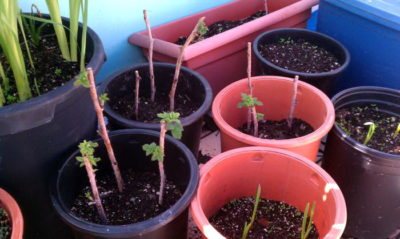

Among the variety of berry crops, the Tarusa raspberry attracts the attention of gardeners with its thick erect stem, which looks like a tree. The plant height is relatively small, up to 1.5 m.
The trunk and leaves of the raspberry bush do not have sharp thorns, which greatly simplifies its cultivation and harvesting. This is a large-fruited plant with a high rate of productivity. It is a pleasure to look after him.
To get sweet and beautiful berries, it is enough to adhere to the basic rules of agricultural technology.
Description of the variety and its characteristics
The Tarusa raspberry variety was bred by the famous professor V.V. Kichin in 1987. To create a new form of berry culture, the Stolichnaya and Shtambovy-1 varieties were used. Already in 1993, the raspberry tree variety Tarusa was available for growing to all amateurs - gardeners.
The main distinguishing characteristics of the variety are:
- Powerful and straight stems are green in the flowering phase, and brown in the resting phase. On each branch 2-3 branches are formed and about 20 berries ripen.
- The surface of the sheet is corrugated, the edge is uneven. The color is dark green. Plaque and pubescence are present.
- The shape of the berries is predominantly blunt-conical, the size is rather large, 7-16 g. Some fruits may have a slightly curved shape. The berries are distinguished by their excellent taste. Their structure is moderately dense, which is a determining factor when choosing a transportable variety.
- The pronounced color of the berries indicates their technical maturity.
- The pulp is juicy, there are small seeds.
Raspberry tree Tarusa is able to withstand low temperatures up to - 30 degrees, winter hardiness is characterized as high.
The plant is convenient to grow in a personal plot, due to the small amount of root growth (up to 5 pieces). Raspberry Tarusa does not tolerate excessive moisture.
Pros and cons of Tarusa berry culture
Among the positive qualities of the Tarusa raspberry variety are:
- High productivity index (up to 4 kg per plant).
- Berries are not afraid of transportation.
- Large-fruited variety.
- High index of frost resistance.
- Discreet root growth.
- Small-seeded berries, which are practically not felt when consumed.
Planting and leaving
Tarusa stock raspberries can be planted in the spring, the optimal planting time is in the last days of April, or in the autumn season - in September. Planting raspberries in the spring is the best option, as the growing process may begin in the fall and the seedlings may freeze.
For information! When planted in spring, the Tarusa raspberry tree in most cases can bear fruit only in the second year. At the same time, care must be correct and timely.
Berry planting rules:
- The plant takes root well and grows on loamy and sandy loamy soils. The acidity indicator of the soil is considered a particularly significant factor; it should be PH6 (slightly acidic). If the soil is acidic, then it is recommended to apply 500 g of lime per 1 m2. Slaked lime must be added to the soil, and quicklime must be crushed and diluted with water. The feeding process consists in scattering fertilizer over the allotted area and burying it to a depth of 20 cm. Subsequent liming of the earth is carried out after 4-5 years.
- Given the susceptibility of the raspberry Tarusa or the raspberry tree, as it is also called, strawberries, tomatoes and potatoes to the same diseases, it is not recommended to plant them side by side.
- At the age of 8-9 years, it is recommended to transplant the bush to a new place, and only after 5 years can the previous place be used.
For information! It is necessary to choose a seat in well-lit areas. It is not advisable to plant under trees, otherwise the quality of the crop deteriorates with a lack of sunlight.
Tarusa raspberry seedlings should be of high quality, with a well-developed root system, stem thickness over 1 cm. Particular attention should be paid to the presence of buds at the base of the shoot, there should be more than three of them. To speed up their regrowth, it is necessary to completely free the saplings of the Tarusa raspberry tree before planting.
Recommendations for planting a raspberry bush:
- If the planting of young seedlings is carried out in the autumn, then the soil must be prepared one month before that, if this process takes place in the spring, then in one week.In the selected area, the land needs to be dug up, and during loosening, 2 buckets of organic fertilizers, 250 g of wood ash and 150 g of nitroammophoska should be added to the soil. This complex of nutrients is designed for 1 m2. Lime is applied only to acidic soil. Top dressing is recommended to be done during the flowering period of the bush.
- The planting pit should be 60 cm wide and 50 cm deep. It is recommended to maintain a distance of 1 m between plantings, and 1.8 m between rows.
- Additionally, you need to add wood ash in the amount of 1 liter of a can per hole.
- It is recommended to deepen the seedlings of the Tarusa raspberry tree to the root collar. After planting, the top layer of soil must be lightly tamped.
- Upon completion, the future tree is shortened at a height of 30 cm, and watered at the rate of 5 liters of water per plant.
- Around the bush, the ground must be mulched with sawdust, humus (layer 10-15 cm).
For the plant to adapt well, it is recommended to make a fabric canopy to protect it from the sun. This care of the plant promotes effective rooting.
Breeding varieties
Reproduction of the raspberry tree is carried out in two ways:
- Root cuttings. To do this, you need to dig in an adult plant and examine the root system for the presence of buds. One cutting should have two full-fledged buds. The selected planting material is cut to the required length and germinated in containers (boxes) filled with a mixture of peat and river sand in proportions 1: 1. Prepared cuttings are exposed to light, and after the roots appear, they are transplanted into separate pots with fertile soil.
- Root shoots. Reproduction in this way is used by many gardeners. To obtain planting material, you need to separate the young shoots from the main bush and plant them in a row. Water the plants, dig in and mulch.
Raspberry pruning
To give a beautiful and neat shape to the plant, gardeners pinch the side shoots. On a raspberry tree, this procedure is done along the entire radius. The best time for pinching is autumn, but if necessary, you can do it in the spring.
The pruning of annual shoots is carried out at a height of 1.3-1.5 m, leaving 6-7 powerful branches. This technique will allow you to get the harvest next year.
Despite the fairly good thickness of the stem, many gardeners still recommend installing a support, given the high productivity of the bush.
The supporting structure should consist of high pillars (1.5-2 m), dug in every 4-5 m. The wire material must be pulled at a distance of 1 m from the surface of this structure.
In the second year, the plant is tied at a height of 30 cm and 1.5 m. Copper wire or rope can be used as a fixing material.
Planting and leaving
The quality of the soil is of great importance. She must be fertile. To improve the quality of the soil, humus and compost are introduced. If it is too acidic, slaked lime is added. In loose soil, it will be easier for raspberry roots to multiply, releasing shoots.
Gardeners' reviews suggest that they are looking for a sunny place for planting, but in some cases it grows well in partial shade. This can save from drought if it is not possible to irrigate the plantings. The berries may be less sweet but larger in size. Often, a raspberry tree is planted on the south side of the garden. But in a dense shade, the fruits will be sour and the plants will be weak. At the same time, raspberry root growth can interfere with tree care.
Groundwater should not come close to the soil surface. This can lead to root rot. If there are no such areas, you can plant bushes on high ridges.
Before planting, layers of peat, humus, sawdust, compost are laid on the bottom of a pit or trench, sprinkling them with earth.
The stem is cut 40 cm, the bush is planted in the ground. The remainder of the stem is cut after the new stems have reached 25 cm.
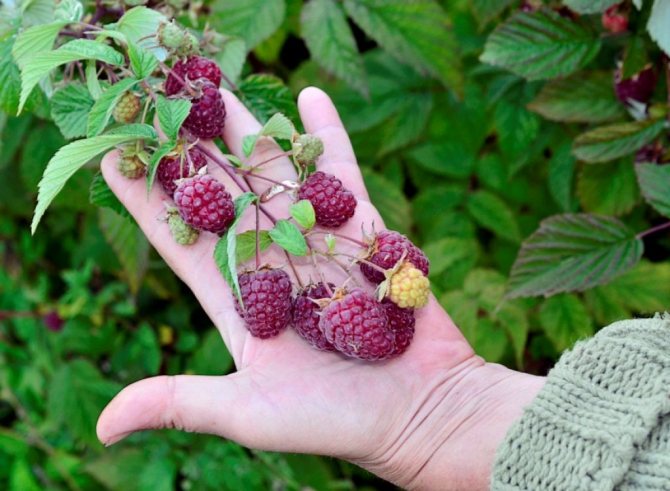

Diseases and pests
The standard variety of raspberries is less susceptible to diseases and pests common in the classic version.
The greatest danger to the crop is the raspberry beetle, which infects flowers and buds. Also, its females lay eggs in already formed berries, which leads to their destruction.
To get rid of the likelihood of completely losing the crop, annual prophylaxis against parasites using insecticidal solutions should be carried out.
A separate problem is the danger of raspberry freezing. There is no doubt that raspberry trees are more resistant to low temperatures, but with annual frosts down to -30ºC, it is necessary to insulate the plants for the winter.
Standard raspberry varieties are resistant plants with high yields and low care requirements. Such varieties of raspberries on the territory of a private farm can not only bring a bountiful harvest of sweet berries, but also serve as an excellent decorative element during their own flowering period.
Boxwood - rules for breeding and caring for an evergreen tree
Is Kupena the same lily of the valley? Growing, breeding methods, varietal variety with photos
Breeding methods and rules for growing periwinkle in the garden
Reproduction methods
Standard raspberries are propagated by cuttings, shoots and rooting of pieces of roots. The easiest way to get a new plant is from the undergrowth. To do this, a daughter plant is dug up and planted in a prepared place in the garden.
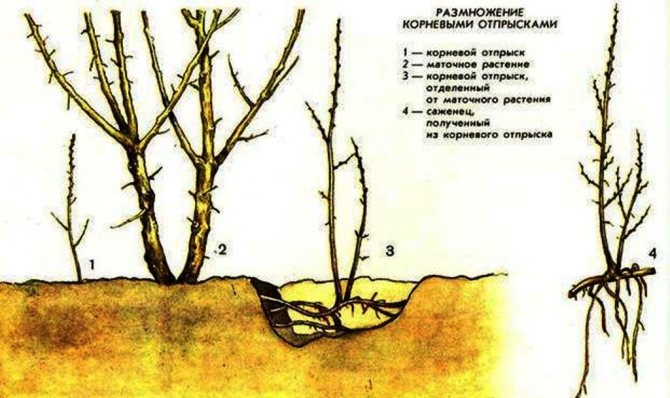

Rooting offspring is the easiest way to propagate standard raspberries
To root the root cuttings, it is necessary to dig in a raspberry bush and select sections of roots with 1-2 buds. The roots are planted in a light, loose substrate on a planting bed. Before the emergence of shoots, the bed is shaded from the sun and kept moist. For the winter, the sprouts are covered with agrofibre. The next spring, the seedling is planted in a permanent place.
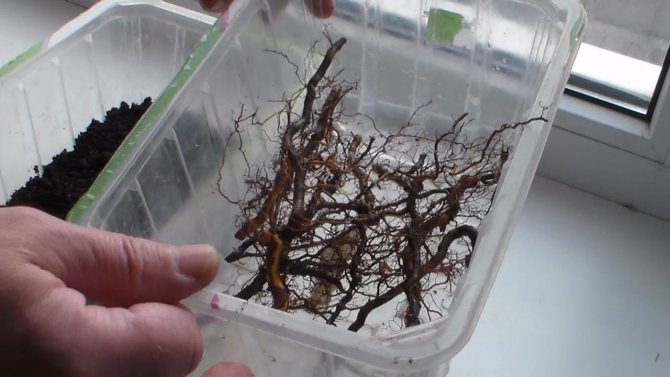

Root cuttings are cut from the dug up raspberry roots
When propagated by green cuttings, young offspring 7–8 cm long are cut out. The slices are dusted with Kornevin or Heteroauxin, after which the cuttings are planted in a mixture of soil and sand, taken in equal amounts. Rooting will take place in about a month, during which time the cuttings need to be kept warm and humid. To create suitable conditions, it is necessary to build a greenhouse in a shady place in the garden and cover it with foil.
It is important that the sun does not fall on the film - otherwise the cuttings will burn out, well, do not forget to air every day. When the cuttings take root and start growing, the film can be removed. For the winter, it is advisable to cover young seedlings with agrofibre, and plant them in a prepared place in the garden next spring. This method of propagation is used when it is necessary to obtain a lot of seedlings.
Recent Entries
Rose Petal Jam and Its 7 Health Benefits You Likely Didn't Know About What Fruit Are You According to Your Zodiac Sign 11 Best Grape Varieties That Will Help You Create Unique Homemade Wine
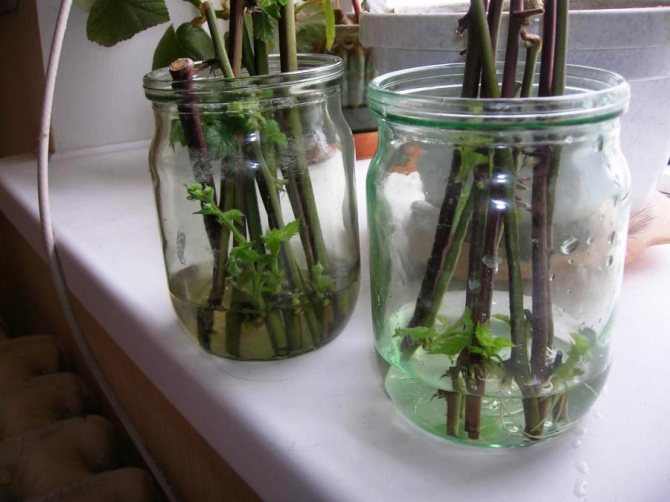

Green raspberry cuttings root easily in water - the main thing is that there is little water, otherwise the shoots will suffocate
The best varieties
Three varieties of raspberry trees have gained the most popularity in Russia. Basically, they have similar characteristics, but there are some minor differences:
- Tarusa. The root system of the bush is like the rhizome of a tree. This red raspberry tree is quite difficult to propagate, but it makes sense to work hard because of the high yield and large sweet berries.
- Strong guy. It has a well-developed root system, which facilitates the reproduction process.
- Story. This variety is derived from Tarusa, therefore they are similar in many characteristics. There are no thorns on the shoots, the yield is high. Disadvantage: does not tolerate winter cold.
Cedar pine: description and useful properties of needles and cones
Landing dates
You can plant standard raspberries in spring or autumn.Planting in the spring before the buds open. When planting in autumn, calculate the time so that the seedlings have time to take root before the onset of severe cold weather (planting is carried out approximately in the last decade of September or at the beginning of October).
Raspberries planted in spring will not yield a large harvest in the first year.
Diseases and parasites
Standard raspberries are endowed with amazing resistance to the bulk of fungal and bacterial diseases. But, like other varieties, it is attacked by insect parasites.
On the bushes of tree raspberries, you can find parasites:
- Raspberry beetle.
- Raspberry moth.
- Gallica.
- Spider mite.
In order to prevent the development of parasites after autumn pruning, as well as in early spring, before bud break, the bushes are treated with a 1% solution of Bordeaux mixture.
If blooming and ovary-forming plantings were affected, the treatments are carried out with preparations of biological origin.
I have been doing gardening for a long time, I grow a variety of varieties of berry and fruit crops. The raspberry tree also grows in the garden - a fruitful crop, a standard variety. Unlike ordinary berry bushes, the tree is large and much more productive. In the article I will tell you more about the raspberry tree, I will share the secrets of planting and caring for it.
Post navigation
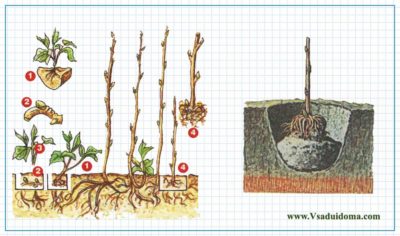

Today we will talk about a very unusual type of raspberry, you are probably all accustomed to the traditional look, raspberry bushes, they are usually undersized and with relatively small shoots, but there is a standard raspberry. It is not that popular, and it is widespread, and completely in vain.
Raspberry tree planting and care, photo, reproduction, this wonderful plant is the topic of our article, we are sure you will like it, because standard raspberries have very good and rich yields, and caring for it is not difficult, see for yourself, try to grow such a tree on your site, with the help of our tips.
How to plant a raspberry tree, basic rules:
It is important to note that standard raspberries, without proper care and proper pruning, will look almost the same as regular raspberries, only with thick trunks. Therefore, gardeners form a crown on their own, if you come across information somewhere that your seedling will grow by itself and take the shape of a real tree - you know, you are being deceived.
Growing a raspberry tree is not particularly difficult, anyone can grow it, since the plant is unpretentious.
The main thing is to take the correct planting material, often old and weak shrubs are given out for young seedlings.
To avoid such a situation, it is better to buy planting material from trusted people, from friends or neighbors, or in stores. In the markets, you need to watch carefully, otherwise you can be deceived.
After you have chosen a healthy, young seedling, you should start planting. To do this, you need to choose a suitable place, it is best suited, a light open area, away from vegetable crops, since they often have the same pests and diseases with a raspberry tree.
The planting time of a raspberry tree is the same as that of a regular raspberry: spring or autumn. If you decide to plant in the spring, then it is best to do this at the very beginning, immediately after the snow melts, and when the soil thaws a little. Autumn planting of standard raspberries is carried out in September. Immediately after planting, the seedlings are spud, about 14 centimeters, this procedure will protect the plant from frost.
Raspberry tree planting scheme:
- Bush method - with this approach, a separate hole is dug under each bush, and no fertilizer is applied to it.
- The belt method is a planting method suitable for a larger country house. You need to dig a long trench and plant a raspberry tree bush every 50 centimeters, following the process, immediately after you dug a trench, you can apply fertilizer into it.
For better rooting, raspberries are dipped in a mullein before planting, or rather not all raspberries, but only their rhizomes. Humus, ash and complex fertilizers are poured into the pits themselves.
Poor predecessors for a plant such as raspberries are: potatoes and tomatoes. But after legumes, the raspberry tree, planting and caring for which after these crops is much easier, and they are considered good predecessors.
How is the care of a raspberry tree:
You probably already guess that special care for the raspberry tree is not needed, all the same recommendations that we gave for growing other varieties of raspberries are also suitable in this case.
- Watering - watering raspberry bushes, as a rule, once a week, but abundantly enough and immediately after that we loosen the ground, we also do after heavy rain. This will protect the roots of the plant from rotting due to the fact that excess moisture may remain there.
- Pruning a raspberry - a raspberry tree does not form into a tree by itself, it is still a shrub, albeit with powerful stems, so to get the correct shape of the tree it must be trimmed accordingly. Also, in the direction of formation of the crown, you need to put a support. The tree is pruned gradually, from bottom to top. Also shorten the side shoots by about 13 to 16 centimeters.
- Top dressing - it's no secret that the key to high yields is the right top dressing, raspberries love it very much, and reacts well to it. Both organic and mineral fertilizers work equally well. Immediately after planting, fertilizers are applied, organic fertilizers are reintroduced in October, before preparing the raspberries for the cold weather. Well suited as fertilizer and humus with manure. During fruiting, fertilize raspberries with organic fertilizers and store-bought ones, for raspberries.
- Garter raspberries for the winter is a necessary measure carried out in October to protect plants from the winter cold. In addition to tying raspberries, they are mulched and covered.
- Weed weeding.
- Disease and pest control. We will consider this point in more detail.
Diseases and pests of the raspberry tree
Pests:
- The crimson beetle is one of the main enemies that lives underground and destroys the aboveground part of the plant, leaves and inflorescences, and the larvae of this beetle threaten the drupes themselves. They fight it by loosening the soil, during which they pay attention to the soil, these insects can often be seen in it. Also, the plant is treated with karbofos.
- Moth - most often the moth lives on the old shoots of the plant, for this reason, they are removed. Also, for the purpose of prevention, the raspberry tree is sprayed with special preparations, even before the buds appear.
- The weevil is a very dangerous enemy, it gnaws the stalks, and lays its eggs in the buds themselves, the offspring completes what they started, as a rule, if nothing is done, the harvest will die. One of the methods of prevention is the choice of a place, since the close proximity to strawberries will almost certainly attract weevils to raspberries. Also, in early spring, pest control is carried out.
- Raspberry fly - in early May, these flies lay eggs in raspberry shoots, after the offspring is born, it begins to destroy the leaves. For prevention, it is recommended to constantly dig up the soil, because flies live there. Also, pest control in early spring will help preserve the harvest.
Diseases:
Gray rot on raspberries
Anthracnose on raspberries.
Raspberry rust
Most often, raspberries are susceptible to various types of spots, gray rot, leaf rust, anthraconse. They are struggling with these ailments with the help of Bordeaux liquid and Hom preparation.
Reproduction of the raspberry tree:
Shoot propagation is the simplest and most effective method of breeding standard raspberries. Since there are a lot of such growths and it takes root well in a new place.
Any outgrowth that has grown by more than 25 centimeters can be planted immediately. Inspect the seedling itself before planting, for the presence of various diseases and pests, it is also recommended to rinse it in a solution of potassium permanganate.
Saplings are best dug up and replanted in the spring.
If you like to perceive information visually, we suggest you watch a video on our today's topic.
How to grow a raspberry tree, video on the topic:
Outcome:
A raspberry tree, planting it and leaving it, is not very different from similar events carried out with ordinary raspberries, you were convinced from the photo that if you form it correctly, it will look like a real tree. If you are interested in our today's article, try to grow such a variety of raspberries in your summer cottage, we are sure you will succeed, and on this we say goodbye to you, all the best and see you soon!
Types and varieties
Raspberries, growing in the form of a full-fledged tree, do not yet exist in nature, just as there is no curly strawberry. Thanks to the selection, Professor V.V. managed to create a variety with a very strong stem, and even a tree from it creates a gardener with the correct formation. The varieties known as crimson trees are more correctly called standard trees. Simultaneously with Kichina, Professor Kazakov also worked on the development of standard varieties. He managed to get standard remontant varieties.
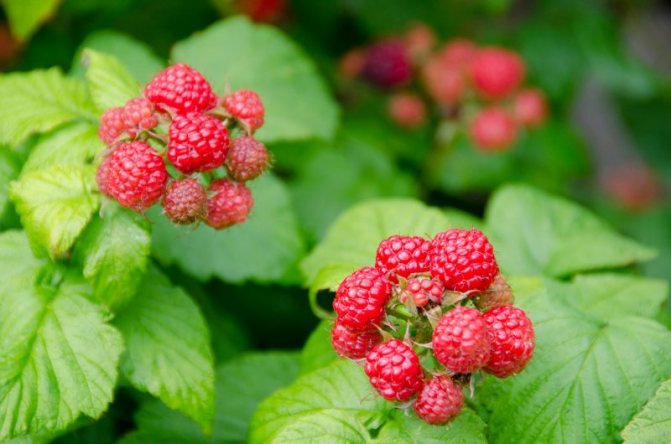

- Tarusa. This is the first standard variety bred by Viktor Valerianovich Kichina. Shoots are low - up to 1.5 m. Fruiting in medium late periods.
- Advantages: large - up to 16 g of berries, high - up to 4 kg per bush yield, no thorns, strong stem.
- Disadvantages: sour taste of berries, insufficient frost resistance - up to -30 degrees. The sprouting ability of the Tarusa raspberry tree is weak - there are enough shoots to replace the fruiting trunks, there may be problems with reproduction.
- Sturdy... The variety has tastier berries than Tarusa. But their value is less - up to 8 g, respectively, slightly less and the yield - up to 3.5 kg per bush. The frost resistance of the variety is at the level of Tarusa. But the sprouting ability is much greater, it is easy to propagate this variety. Bears fruit in the mid-term. The berries ripen unevenly and must be picked frequently. They are well transported.
- Story. Ripening period - medium, extended fruiting. The shoots are high - up to 2.5 m. The berries are not inferior in size to Tarusa - up to 15 g, but the yield is much higher - up to 10 kg per bush. The taste is good with a high sugar content. The weak point is the low frost resistance of -25 degrees for it, the limit, and bending down the standard variety for wintering under cover is a thankless task.
- Eurasia - the first grade of standard raspberry with remontant fruiting. The height of the shoots is 1, 7 m. Frost resistance in this case does not matter, the shoots are cut at the root in the fall. The variety is distinguished by moderate shoots, which is more a plus than a minus: this raspberry will not creep in all directions. The berries of Eurasia ripen in early August, and until the end of September, it fully yields. The berries are large - up to 6.5 g of a beautiful dark raspberry color. Their tasting score is 3.9 points, probably due to a noticeable sourness, but it accumulates vitamin C up to 35 mg. The advantages of the variety include excellent yield - up to 6 kg per bush and transportability of berries. The ability to be stored for several days without loss of consumer qualities is rarely seen.
- Penguin. The shoots are low - up to 1.5 m. Medium-sized berries - up to 5 g, as well as the yield - 2.5 kg. The flavor of the berries is highly dependent on the type of soil and weather. Frost resistance up to -26 degrees, but this is not important for a remontant variety. Fruiting from early August until frost.
Fertilizers for feeding stock raspberries
In early spring, it is advisable to feed the "raspberry tree" with a solution of urea in a dilution of 50 grams of granules per 10 liters of water per 3 bushes.Organic feeding with infusion of bird droppings or mullein is also possible. Before flowering - in early May, it is good to feed with an aqueous solution of nitroammofoska or nutrivant drip (2 tablespoons per 10 liters of water for three bushes).
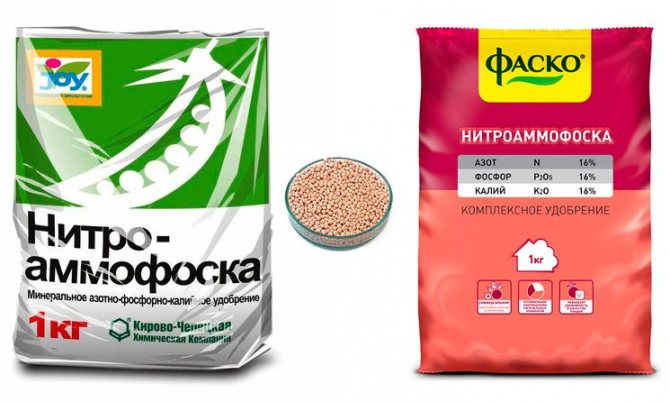

Good results are shown by monthly foliar feeding on foliage from the beginning of budding with solutions of multi-microelements: "Ryazanochka for berry crops" (for 10 liters of water, 1 teaspoon of the product) or "Nutrivant plus fruit" (for 10 liters of water, 2 tablespoons of the product). There is a very useful anti-stress drug "Aminokat 30%", which is used for spraying stock raspberries in unfavorable weather conditions: late frosts, heat and sunburn, with mechanical damage to branches.
How to propagate standard raspberries with green cuttings
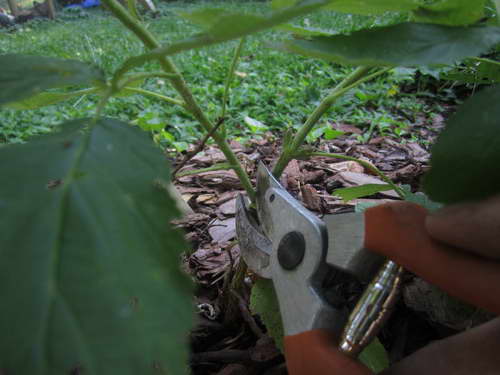

Reproduction of raspberry tree by cuttings step by step instructions with a photo
Cut green cuttings 25-30 cm long in the summer, remove the lower leaves and keep the cuttings in a solution of root or heteroauxin for 24 hours.


Cuttings of a raspberry tree photo of cuttings
After that, plant in prepared individual containers with loose nutrient soil and drainage holes.
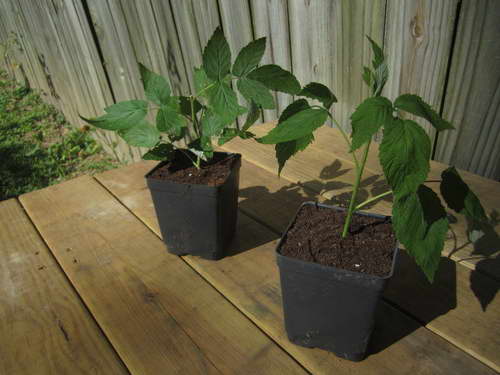

How to propagate standard raspberries with green cuttings
You can place it in a well-lit room, on the porch, in the gazebo or in the garden under the trees. Water as the soil dries.
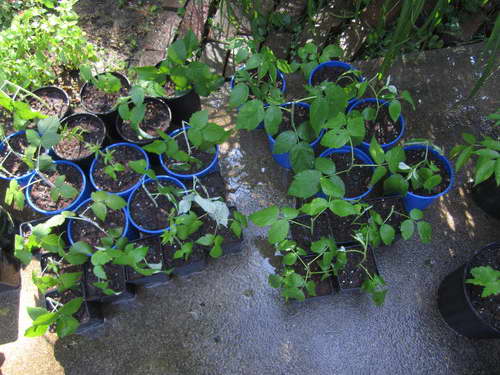

Reproduction of tree raspberries by green cuttings photo
By the end of summer and early autumn, the cuttings will root well and will be ready for planting on the site. To prevent the death of young plants, thoroughly mulch the trunk space with leaves or straw with a layer thickness of 15-20 cm.
Pruning remontant raspberries for the winter
For raspberries that repeat fruiting, that is, remontant, there are separate pruning rules. Fruiting of remontant varieties begins a little later than traditional ones, but the harvest continues to be harvested until late autumn, often before the first frost. For this reason, pruning is carried out only after fruiting and growth of the bush. There are 2 variants of this operation for remontant varieties.
- Good times to do basic pruning are winter and early spring. The simplest version is to cut all the shoots low above the ground. Young shoots will start growing in April, bearing fruit in late summer and autumn.


- The second, slightly more complicated method of pruning remontant raspberries, is to cut only parts of the shoots low. The remaining shoots are cut in half. On the rest of the shoots, fruiting begins next summer. Thus, fruiting on these shoots will be several weeks earlier than on stems germinating in spring, on which fruiting, in turn, begins in August and ends in October. This is the additional purpose of pruning remontant raspberries in the fall.


Features of growing standard raspberries
First, to grow standard raspberries you need full daylight sunlight, which can be achieved by placing rows of raspberry bushes when planting from south to north in your garden area.
- The growing soil must be well-drained and fertile;
- soil fertility is formed no later than 1 month before planting, when 2 buckets of humus, 150 grams of nitroammophoska and a glass of ash per 1 running meter are introduced into the prepared landing strip, 60 centimeters wide. It is recommended to dig up such soil for 1 bayonet with a shovel or a motor-cultivator;
- best planting dates: from mid-September to late autumn; in spring - from early March to late April, and with mild winters in the southern regions - even in winter;
- when planting, the bushes are placed in one line with an interval of 50 centimeters. Nitroammophoska 1 tablespoon is added to the landing hole.
Standard raspberry varieties with photos and descriptions
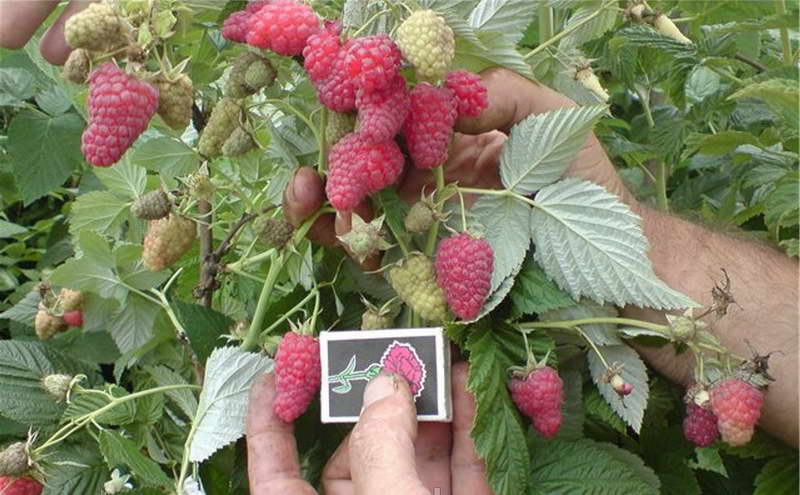

Raspberry standard Tarusa photo
Tarusa is the most common in horticulture, the first among domestic ones.The berry is elongated-conical, large (weighing 4-12 g), bright red in color with a pleasant aroma. After the formation of the "crown" of the seedling, no further pruning is needed, the rhizome does not spread over the site. It can be grown everywhere in Russia - it winters well in any climatic conditions, but in cold regions preparation for winter will be required (the shoots are bent to the ground, and then covered with a layer of snow).
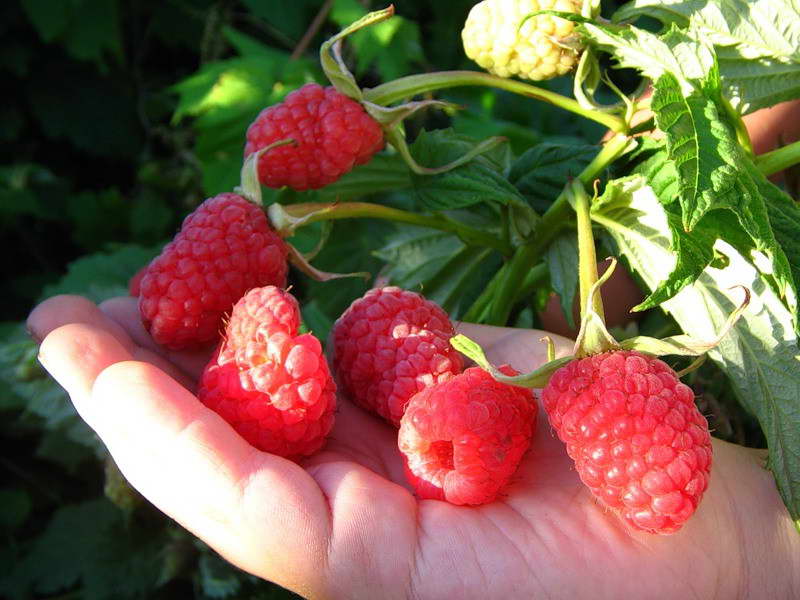

Standard raspberry Krepysh photo
Strong - reproduces well by cuttings, gives a lot (in comparison with the rest) replacement stems. High-yielding variety - yields about 4 kg of berries per bush. Fruits are oblong, about 10 cm long. Fruiting is stable regardless of external conditions.
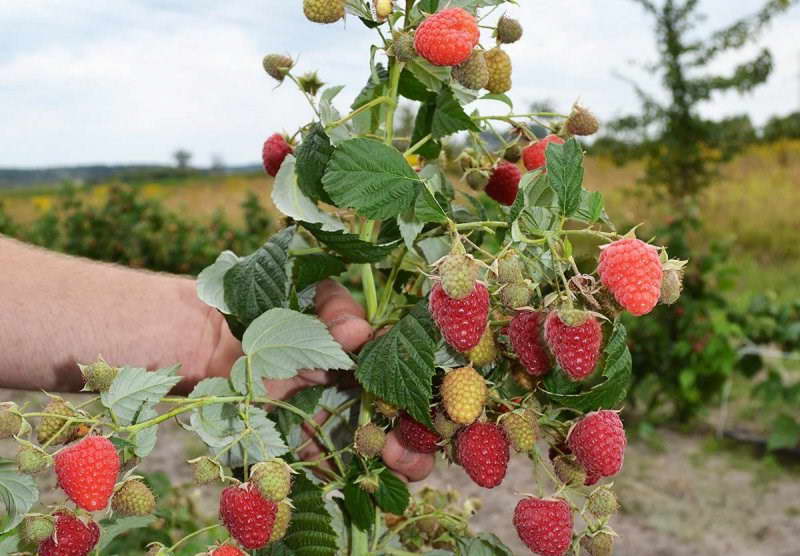

Standard raspberry Fairy tale photo
The tale is a high-yielding variety (about 12 kg of berries can be harvested from one adult bush). The fruits tolerate transportation well. The bush forms a strong root system and strong growth, which increases its resistance to cold weather.
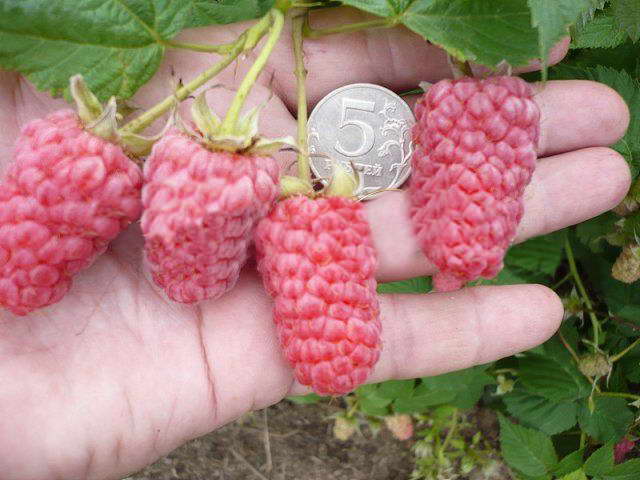

Raspberry standard Galaxy photo of berries
Galaxy. The bush is characterized by an average growth rate. It is medium spreading and does not form thorns. On the shoots, large berries develop with a mass of about 10-18 g. The variety is distinguished by good winter hardiness.
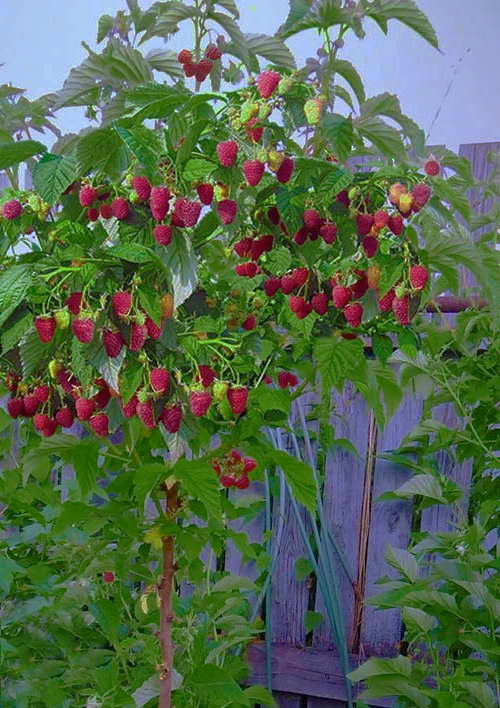

Standard raspberry Bogatyr photo of a bush with berries
Bogatyr. The bush forms well-developed shoots with no thorns. Dessert-type fruits. They are tapered and large in size. Good winter hardiness of the variety, its transportability and resistance to various pathogenic microorganisms were noted.
Other popular tree raspberries include:
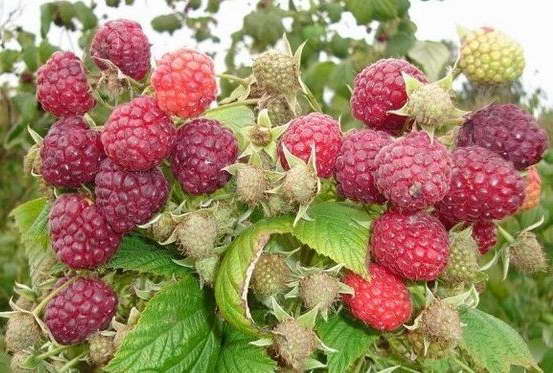

Standard raspberry Penguin photo
Penguin and Eurasia are very similar varieties. The height of the bush does not exceed 1.3 m, at the end of fruiting, all shoots are cut almost at the root. The berries are large (weighing about 5 g). The fruiting period is July-September.
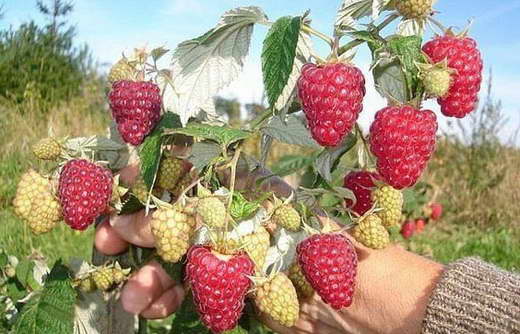

Standard raspberry Giant photo
Giant - the bush is about 1.8 m high. The berries are bright red, weighing 8-12 g, do not crumple during transportation.
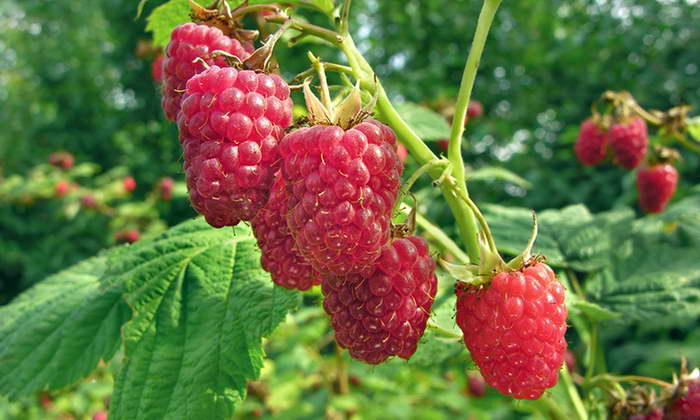

Standard raspberry Glen Ample photo
Glen Ample - the variety perfectly adapts to various types of soil and climatic conditions.
How to choose seedlings
Standard raspberry varieties give a small number of replacement shoots - its reproduction is difficult, which causes a high price for planting material. Raspberry tree seedlings are best purchased from specialized farms, fruit and berry stations or nurseries. You will be provided not only with high-quality planting material (in random places of sale there is a risk of bumping into scammers), but also corresponding to zoning (climatic conditions of your region).
Care
The only desire to get a large harvest is not enough. For good results, it is necessary to provide the vegetation with the necessary care.
The main rules in the matter of caring for raspberry trees are:
- To plant a raspberry tree, you need to select an illuminated area on the site and prepare the soil - high-quality drainage is required, with the expectation of the outflow of excess moisture.
- Fertilizers should be applied 30 days before the expected planting of raspberry trees. Optimal for this culture are humus, ash and nitroammophoska.
- It is possible to plant in prepared soil in the spring and autumn periods, adjusted for warm regions - if weather conditions permit, the procedure can be performed in winter.
- The gaps between individual plants should be at least 0.5 m. The standard crop prefers spacious places and this distance should be sufficient.
- The rows should be placed at a wider distance, since the crown of the raspberry tree is quite extensive. 2 m will be sufficient for normal growth and harvesting.
- Immediately after planting the seedlings in the holes, it is necessary to carry out additional fertilizing together with the primary watering. To do this, add 1 tsp.nitroammofoski for each separate bush.
- During the fruiting season, it is required to provide a sufficient amount of water - the land should not dry out, otherwise fruiting will be reduced or completely stop.
- In preparation for winter, you should cut off the branches, leaving no more than 6 of the most powerful shoots. For remontant varieties (Eurasia or Penguin), the procedure differs in that all branches are removed at the root.
Other norms are no different from the classic option for caring for raspberries.
If the gardener has a similar experience, there should be no difficulties.
However, each of the varieties may have their own weaknesses. All such moments are usually indicated in the description on the site of the supplier of seedlings.
Attention! During the disembarkation period, the temperature indicator is an important point - if a decrease from 15ºC is expected in the near future, it is better to postpone the procedure.
In the first year of the life of the raspberry tree, a small crop is collected. This is due to the need to adapt the plant to the soil and environment.
When the plant is fully accustomed, the entire tree is covered with fruiting branches.
Features of irrigation and the choice of the optimal location
The approximate volume of water for standard varieties is 1 bucket per week for each tree.
However, it is necessary to take into account the weather conditions - if water stagnates in the soil, root rot may begin, which will lead to the death of the culture.
The ground water level at the site should not approach the surface closer than 1.5 m.
Among other recommendations for the location of raspberry trees, there are:
- Medium shaded area with protection against drafts.
- During winter, the landing site should be evenly covered with snow.
- A fence or outbuildings can be located next to raspberries, but no closer than 1 m.
- You should not place a standard crop near potatoes, tomatoes or strawberries, since they have common diseases.
- If raspberries grew on the site earlier, they can be planted in the same place no earlier than 3-4 years later.
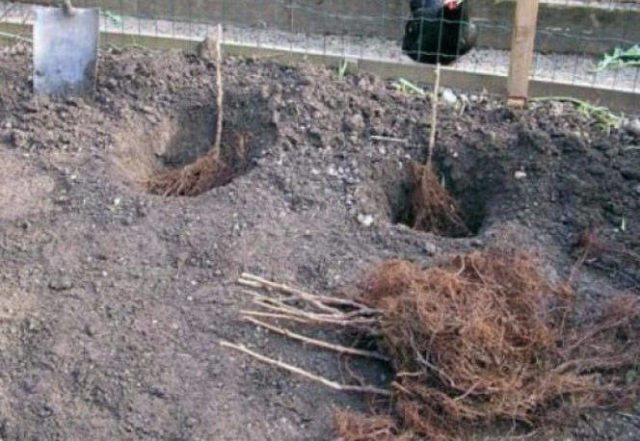

Raspberry care
The soil on the territory where the standard raspberry is located must be put in order after disembarkation.
This requires the simplest procedure:
- Weed weeding. This approach will free the soil from the plexus of roots of extraneous plants, thereby providing oxygen access and reducing the likelihood of overheating.
- Tilling the land with a cultivator and a rake allows mixing the upper layers for an even distribution of nutrients and more free passage of water to the root system of raspberry trees.
- Mulching the soil with compost, sawdust and peat mixtures will increase the fertility of the soil, retain moisture for a sufficient time and reduce the rate of development of weeds.
Attention! If the forecast of weather conditions for the winter presupposes significant frosts, the shoots remaining after pruning should be bent down before the onset of warmth and the area with the raspberry bush should be covered with breathable agrofibre.
Pinching adult specimens
To obtain an increased yield 2 times a year, it is recommended to pinch adult plants in the autumn season.
At the same time, preventive pruning is carried out in the spring, taking into account the cutting of exclusively dried up shoots.
If you pinch the plants in autumn and spring, the raspberry harvest is removed 1 time per season.
After the procedure, it is imperative to carry out the prevention of diseases by treating the trees with special compounds in general, and pinching places with a 3% iodine solution.
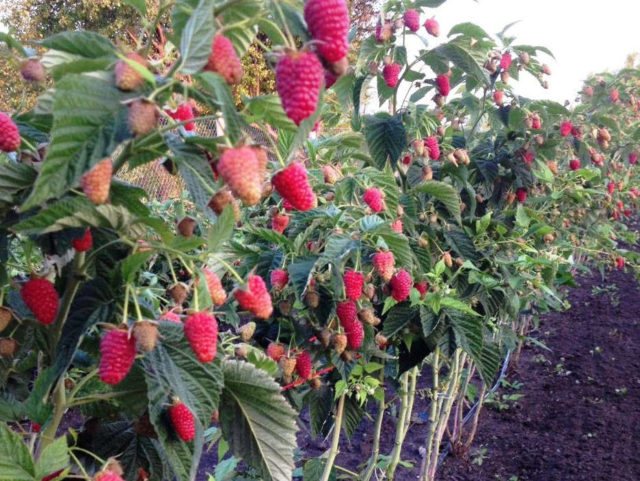

With strict control and preliminary calculation, both options can be used to ensure yields with the ability to plan your own departures during the warm season.
Formation of the correct crown
To increase the yield of raspberry trees, it is necessary to properly form the crown of the plant. For this, adult units are pruned in 2 stages:
- The initial pinching of the tree should be done in late spring, May is the optimal time for the procedure. The optimum height of a specimen suitable for pruning is 60 cm. The branches are shortened only by 5-10 cm, which makes it possible to activate growth points near the nearest joint and form a branch on the plant.
- The second stage is carried out a year later - the branches of the second order formed at the pinching sites should be subjected to a similar procedure, taking into account the shortening by 15 cm.
The shoots that will develop at the pinching sites after the second stage belong to the third order.
They can bear fruit by autumn, which will give a bountiful harvest.
Fertilizing raspberries in the autumn
To preserve the qualities of raspberry trees and obtain an annual yield with stable indicators, it is recommended that each one very much feed the raspberry tree.
For this purpose, the following procedures are performed:
- A dozen plants require 3-4 buckets of mullein for normal development.
- The soil, after fertilization, should be superficially covered with sawdust or peat.
- It is recommended to mix about 1 cup of urea with sawdust.
Reference! The use of nitrogen fertilizers as a supplementary food for raspberries is not recommended, as it causes the development of side branches that do not yield a crop.


